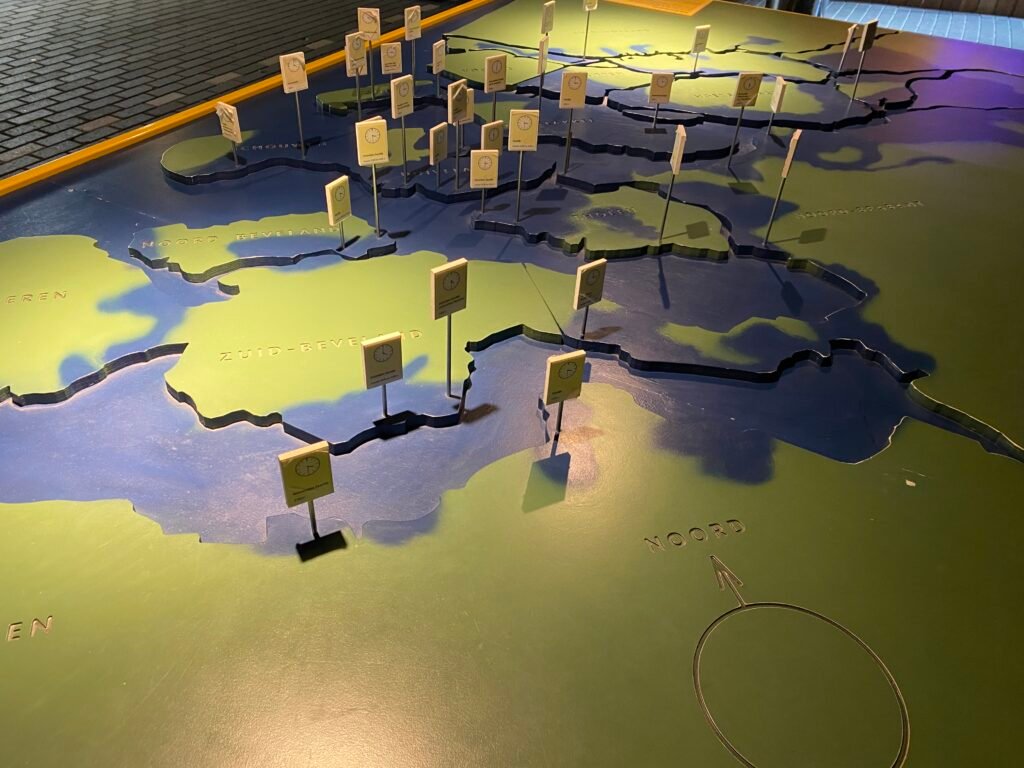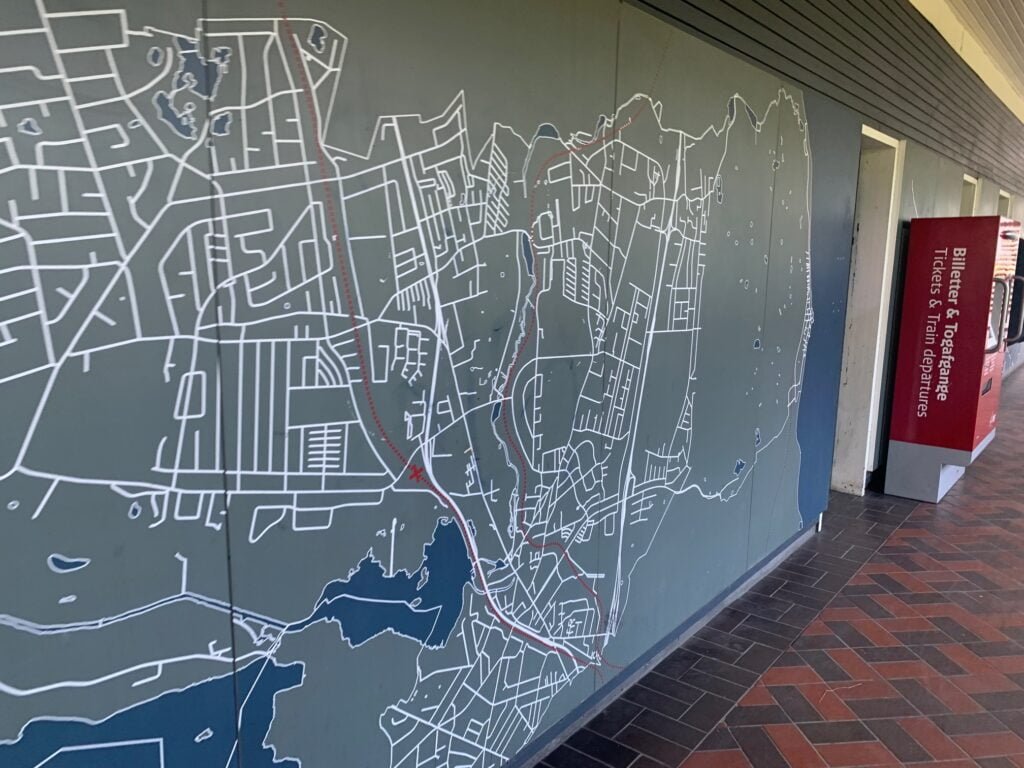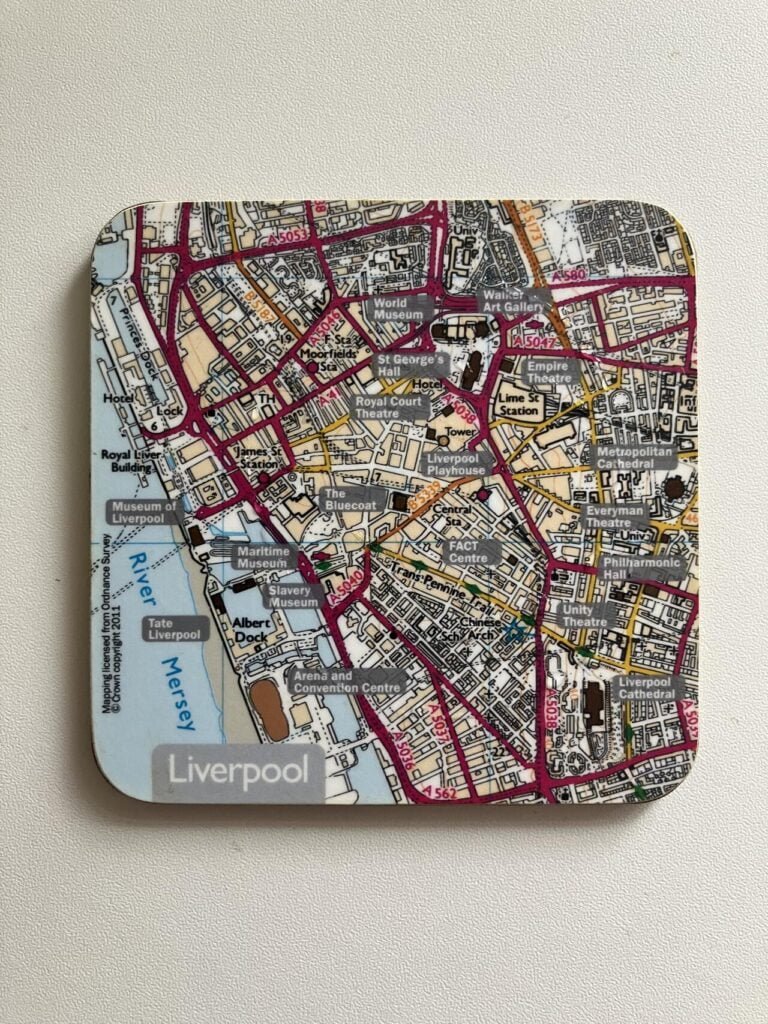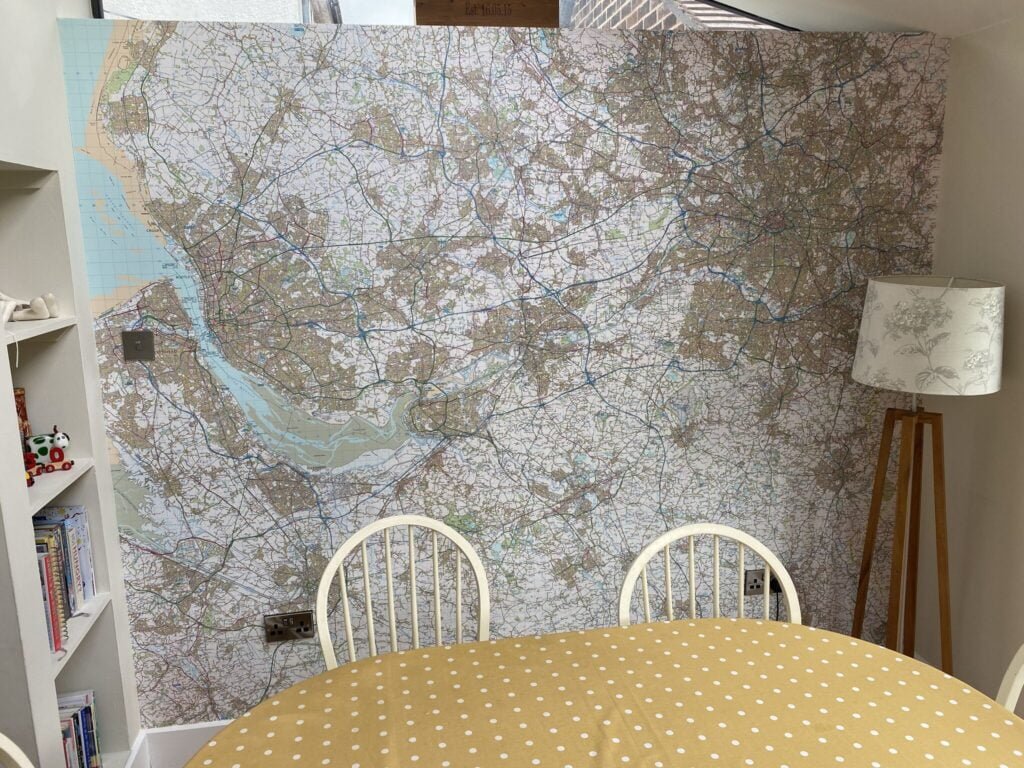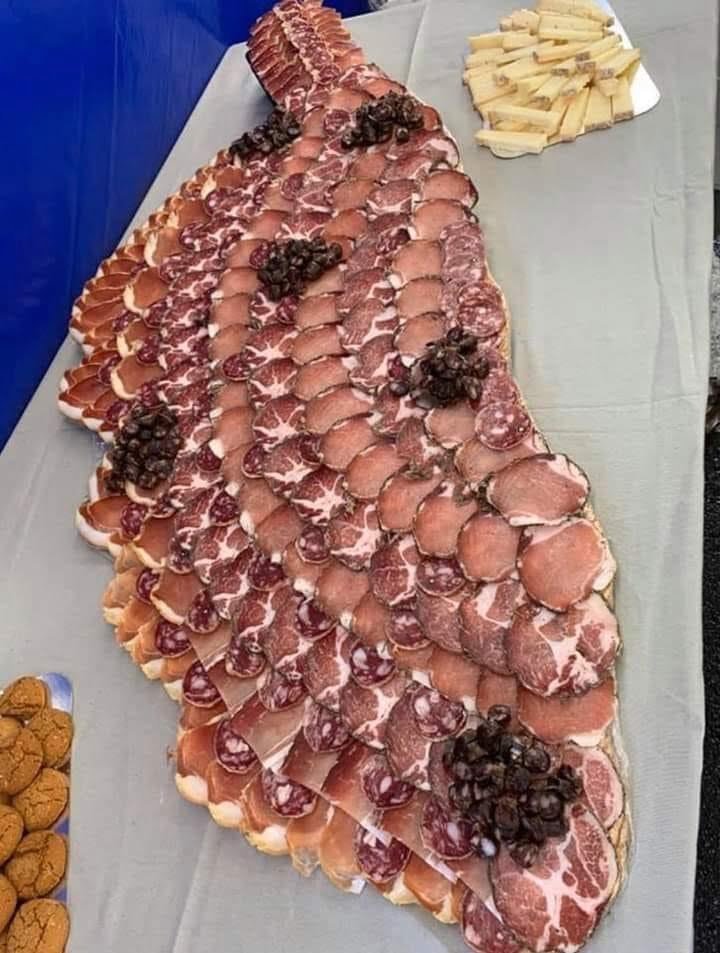Vous pouvez lire le billet sur le blog La Minute pour plus d'informations sur les RSS !
Canaux
7074 éléments (541 non lus) dans 56 canaux
 Dans la presse
(402 non lus)
Dans la presse
(402 non lus)
-
 Cybergeo
(335 non lus)
Cybergeo
(335 non lus) -
 Revue Internationale de Géomatique (RIG)
Revue Internationale de Géomatique (RIG)
-
 SIGMAG & SIGTV.FR - Un autre regard sur la géomatique
(6 non lus)
SIGMAG & SIGTV.FR - Un autre regard sur la géomatique
(6 non lus) -
 Mappemonde
(60 non lus)
Mappemonde
(60 non lus) -
 Dans les algorithmes
(1 non lus)
Dans les algorithmes
(1 non lus)
 Du côté des éditeurs
(19 non lus)
Du côté des éditeurs
(19 non lus)
-
Imagerie Géospatiale
-
 Toute l’actualité des Geoservices de l'IGN
(15 non lus)
Toute l’actualité des Geoservices de l'IGN
(15 non lus) -
arcOrama, un blog sur les SIG, ceux d ESRI en particulier (4 non lus)
-
 arcOpole - Actualités du Programme
arcOpole - Actualités du Programme
-
Géoclip, le générateur d'observatoires cartographiques
-
 Blog GEOCONCEPT FR
Blog GEOCONCEPT FR
 Toile géomatique francophone
(91 non lus)
Toile géomatique francophone
(91 non lus)
-
Géoblogs (GeoRezo.net) (5 non lus)
-
 Conseil national de l'information géolocalisée
(11 non lus)
Conseil national de l'information géolocalisée
(11 non lus) -
 Évènements – Afigéo
Évènements – Afigéo
-
 Geotribu
Geotribu
-
 Les cafés géographiques
(5 non lus)
Les cafés géographiques
(5 non lus) -
 UrbaLine (le blog d'Aline sur l'urba, la géomatique, et l'habitat)
UrbaLine (le blog d'Aline sur l'urba, la géomatique, et l'habitat)
-
 Icem7
Icem7
-
 Séries temporelles (CESBIO)
(2 non lus)
Séries temporelles (CESBIO)
(2 non lus) -
 Datafoncier, données pour les territoires (Cerema)
Datafoncier, données pour les territoires (Cerema)
-
 Cartes et figures du monde
Cartes et figures du monde
-
 SIGEA: actualités des SIG pour l'enseignement agricole
SIGEA: actualités des SIG pour l'enseignement agricole
-
 Data and GIS tips
Data and GIS tips
-
 Neogeo Technologies
Neogeo Technologies
-
 ReLucBlog
ReLucBlog
-
 L'Atelier de Cartographie
L'Atelier de Cartographie
-
My Geomatic
-
 archeomatic (le blog d'un archéologue à l’INRAP)
archeomatic (le blog d'un archéologue à l’INRAP)
-
 Cartographies numériques
Cartographies numériques
-
 Veille cartographie
Veille cartographie
-
Makina Corpus (1 non lus)
-
 Oslandia
(2 non lus)
Oslandia
(2 non lus) -
 Camptocamp
(51 non lus)
Camptocamp
(51 non lus) -
 Carnet (neo)cartographique
Carnet (neo)cartographique
-
 GEOMATIQUE
GEOMATIQUE
-
 Le blog de Geomatys
(2 non lus)
Le blog de Geomatys
(2 non lus) -
 Geomatick
Geomatick
-
 CartONG (actualités)
CartONG (actualités)
-
 Afigéo
(12 non lus)
Afigéo
(12 non lus)
 Géomatique anglophone
(19 non lus)
Géomatique anglophone
(19 non lus)
 opensource
opensource
-
 13:00
13:00 Mappery: yNot Festival
sur Planet OSGeo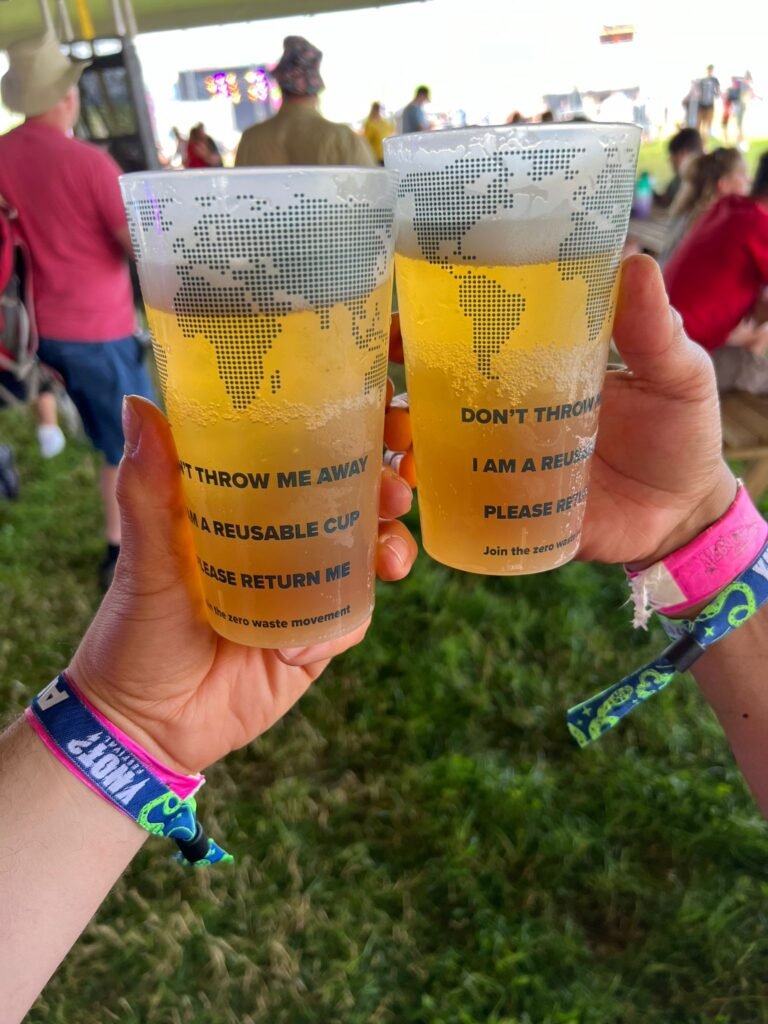
Jeremy shared a pic of the recyclable beer glasses at the yNOT festival. Is that a semi-conical projection?
MapsintheWild yNot Festival
-
 12:20
12:20 Markus Neteler: GRASS GIS 8.4.0 released
sur Planet OSGeoThe GRASS GIS 8.4.0 release provides more than 520 improvements and fixes with respect to the release 8.3.2.
The post GRASS GIS 8.4.0 released appeared first on Markus Neteler Consulting.
-
 13:00
13:00 Mappery: Zierikzee
sur Planet OSGeo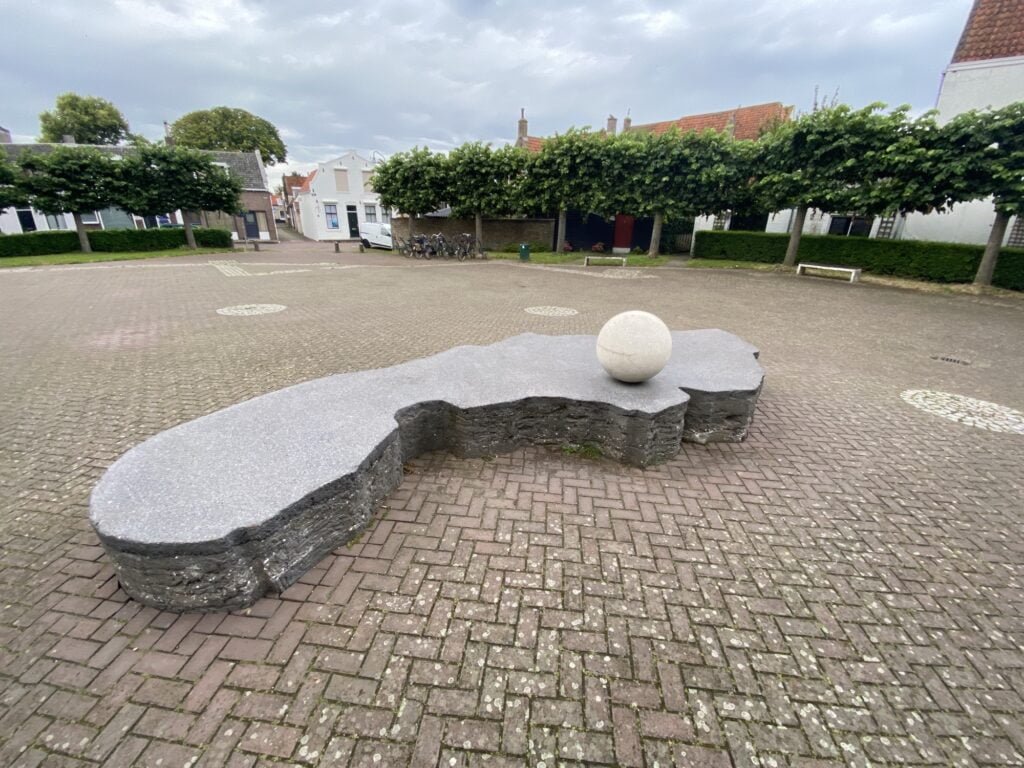
Reinder sent us this interesting map sculpture “I spotted this specimen of street furniture — in fact: my wife did. What you see is the outline of the island Schouwen-Duiveland, part of the Dutch province Zeeland. The white ball is actually on the spot of the town Zierikzee. Very quiet and charming now, but it has quite a notorious history. “
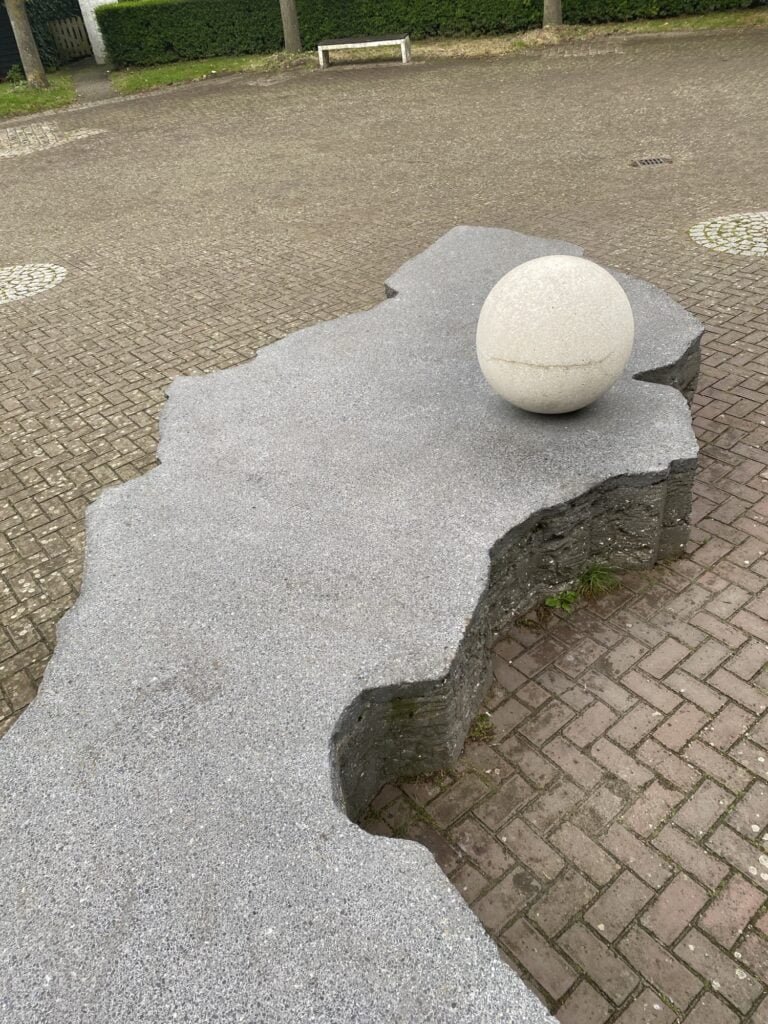
Well done Mrs Storm!
MapsintheWild Zierikzee
-
 23:40
23:40 Jackie Ng: Announcing: MapGuide Open Source 4.0 Beta 2
sur Planet OSGeoThis took way longer than expected, but the 2nd beta release of MapGuide Open Source is now available.
The main driver for this release is to update our various web tier components to their latest respective versions:
- PHP 8.1.29
- Apache [httpd] 2.4.62
- Apache Tomcat 9.0.89
- Installer
- Newer libpq.dll (PostgreSQL 16.3) bundled with Windows installer
- Server Tier
- Fix instability on Linux due to criss-crossed resolution of sqlite3 and geos symbols to our shared libraries instead of the distro-provided versions
- Repository admin tools have been momentarily pulled from this and future beta releases until the admin scripts have been updated and/or rewritten. As a workaround, use MapGuide Package files to backup/restore repository content
- Removed immature MVT tile rendering support. If you want to produce Mapbox Vector Tiles, use any tool from this list
- Web Tier
- Fix QUERYMAPFEATURES SelectionKey containing a newline char, breaking client-side reconciliation of selected features
- More PHP8 compatibility fixes in PHP AJAX Viewer
- Fix bad instanceof exception checks in PHP AJAX Viewer
- More PHP8 compatibility fixes in Site Administrator
- Buffer overflow fixes in WMS/WFS service layer
- New optional --bind-to parameter for MgDe [HttpServer]
- InstantSetup
- Fix crash if no setup log path specified when configuring
- Samples
- Fix bad extents in SheboyganXYZ tileset
Download
Note: Trac is a bit flaky right now, so the release notes page may not display. If that happens just retry with browser refreshes. Failing that, you can find all the necessary download links in my release announcement email -
 17:40
17:40 WhereGroup: Plugins entwickeln für PhpStorm am Beispiel von Mapbender
sur Planet OSGeoIntegrierte Entwicklungsumgebungen (IDEs) bringen von Haus aus schon viel Funktionalität mit. Fehlt allerdings noch eine Funktionalität, lässt sich diese oft auch über ein selbst entwickeltes Plugin ergänzen. -
 13:00
13:00 Mappery: Canada Dry
sur Planet OSGeo
Kate shared this “Neat (and mappy!) Final Jeopardy trivia from the other night: “Early 1900s labels for this beverage brand featured a beaver sitting on a log at the top of a map.”
I am wondering whether the “Dry” refers to the taste or Prohibiton
MapsintheWild Canada Dry
-
 13:00
13:00 Mappery: Maps in a Bar
sur Planet OSGeo
When Erik was in Dubrovnik for a conference he ended up in this bar with colleagues. “With the #CLGE delegates you always end up at a #MapsintheWild bar…”
MapsintheWild Maps in a Bar
-
 13:00
13:00 Mappery: The Neighbourhoods of Ghent, piece by piece
sur Planet OSGeo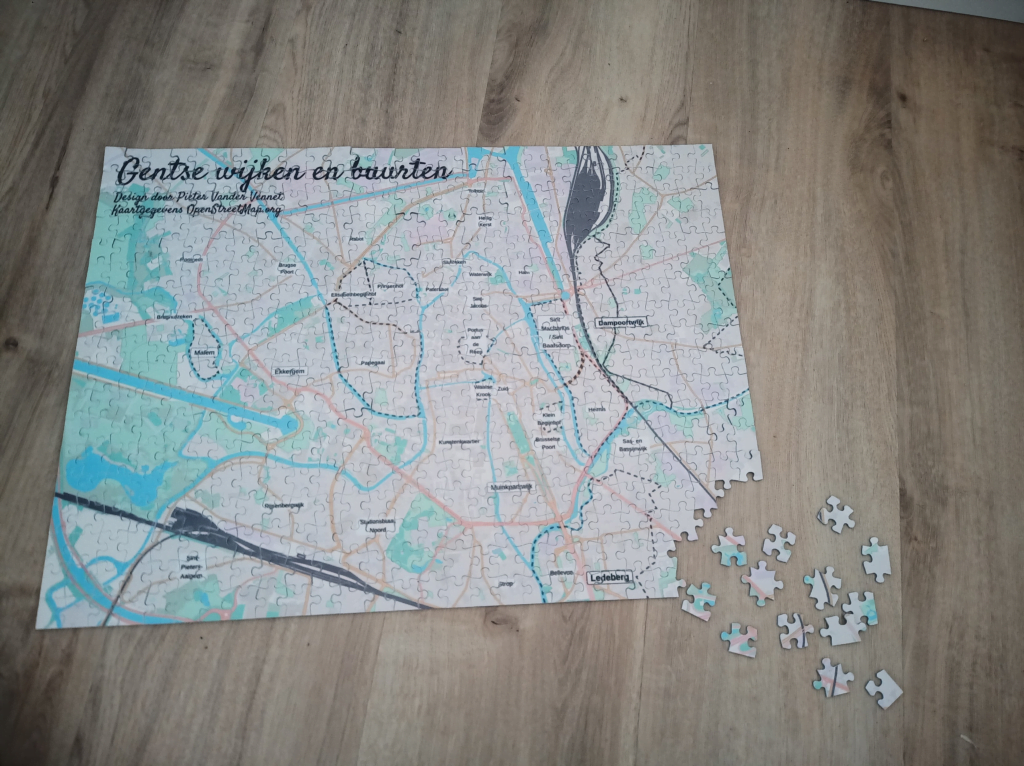
Pieter is a true map geek.
“I wanted to learn the names of the neighbourhoods in #Ghent, so I made me a #puzzle. I added the neighbourhoods in #OpenStreetMap , then made a custom theme in #MapComplete and use the ‘export as PNG’-functuon. The background is a modified stylesheet for @protomaps“
I did say true map geek!!
MapsintheWild The Neighbourhoods of Ghent, piece by piece
-
 4:28
4:28 Sean Gillies: Bear scratch
sur Planet OSGeoI just emailed the Bear 100 race director, Cody Draper, and said that I'm injured and won't recover in time to start in 6 weeks. I'm also too injured to do Black Squirrel in 3 weeks and will be emailing Nick and Brad next.
What's the injury? When I came home from vacation and started to ramp up my running, my right Achilles tendon became sore and very inflamed. On July 17 I went out for a 30 mile run and had to bail at mile 20. I took some time off from trail running and have been chugging on an elliptical trainer at my gym. Yesterday I tried some running on the bike path behind my house and couldn't even go a mile without excruciating pain. I'm calling it, my season is over. The last time I had serious Achilles tendonitis like this was at the end of my ultimate frisbee career 20 years ago. It took 4 months before I could run without pain. I'm going to keep going to the gym, ice and rest, see some specialists, and get ready for 2025.
-
 13:00
13:00 Mappery: Serbo-Montenegrin Attack on Dubrovnik
sur Planet OSGeo -
 14:05
14:05 QGIS Blog: Plugin Update – July, 2024
sur Planet OSGeoFor the last month of July, one short of 30 new plugins were published in the QGIS plugin repository.
Here follows the quick overview in reverse chronological order. If any of the names or short descriptions catches your attention, you can find the direct link to the plugin page in the table below:
MariaDB to QGIS Fetches longitude (x) and latitude (y) data from MariaDB and writes it to a Shapefile or GeoPackage and adds it to your map. Print Selection Outputs selected features to text console. DeraPro DeraPro for projects and studies allows the download of the reference spatial data of Andalusia and make a cut of the information for a specific study area. QPackageQGZ QPackage is a tool to save both your QGIS project and data contained in the project to a new directory. ArgentinaGeoServices A QGIS plugin to import WMS Geoservices from Argentina. T Vertical Sessions Used to Vertical Sessions of Lidar Point Cloud. BuenosAires Converter A QGIS plugin that converts layers to EPSG:9497. Make Sector Plugin to create sector, circle radius, and spidergraph delimited and vector layer. CBERS-4A WPM Explorer The CBERS Explorer is a specialized plugin developed to facilitate the search and retrieval of images from the China-Brazil Earth Resources Satellite (CBERS) program, specifically focusing on the CBERS-4A satellite with Wide Field Imager (WPM) data. FPT Plot Alocation Plot alocation for forest inventory. QGISpell Creates context menu spell checking for attribute data based on ENCHANT libraries. ur-scape Data Importer Import data to ur-scape. MorphAL MorphAL plugin for QGIS. LER+ Nem adgang til LER2 forespørgsler. Threshold to ROI Create ROI (Region of Interest) with threshold values. Spell Checker Check the spelling of words in Print Layout elements. Filter By Selection Filter a given layer by the selected feature and attribute of another layer. Natur i Norge kartlegging Natur i Norge (NiN) mapping tool. AIAMAS – AI-Assisted Map Styler Symbolize your vector layers in seconds. Sentinel 2 Image Downloader This plugin allows users to download Sentinel-2 images. MapSafe Safeguard datasets using masking, encryption and notarisation. GPX Maker for GARMIN® devices This plugin exports GPX files for GARMIN® devices. QGIS Sound Effects Add sound effects to QGIS to make work less boring. Mosaic Tool A plugin to mosaic bands from selected raster layers. Polaris QGIS interface for Polaris through Polaris-Studio ArcGeek Calculator A comprehensive toolset for coordinate calculations, conversions, spatial operations, watershed analysis, land use analysis, and flood simulation in QGIS. Auxiliary Labeldata Importer Helps you to import Labeldata, stored in an auxiliary Layer from another Project. Sections Creates a section polygon layer from a point layer. Slownik warstw Tworzy s?ownik w formie pliku txt rozdzielanego tabulacjami dla wybranych warstw, program pozwala na eksport pe?nych nazw pól danej warstwy oraz wersje jako powstanie po zmienie z gpkg do shp. -
 13:00
13:00 Mappery: Asia?
sur Planet OSGeo -
 20:43
20:43 Fernando Quadro: Curso de GeoNode: Inscrições abertas
sur Planet OSGeoAprenda a criar a sua própria Infraestrutura de Dados Espaciais com o GeoNode, uma plataforma para gestão e publicação de dados geoespaciais que reúne projetos open source maduros e estáveis sob uma interface consistente e fácil de usar, permitindo que os usuários, compartilhem seus dados de forma rápida e fácil.
Este curso visa capacitar os profissionais no uso eficiente da plataforma GeoNode, e tem como objetivos:
 Familiarizar os participantes com os conceitos fundamentais do Geonode e suas capacidades.
Familiarizar os participantes com os conceitos fundamentais do Geonode e suas capacidades.
 Explorar o funcionamento de servidores de mapas e seus benefícios.
Explorar o funcionamento de servidores de mapas e seus benefícios.
 Apresenar como realizar a criação de usuários e grupos de acessos às suas informações.
Apresenar como realizar a criação de usuários e grupos de acessos às suas informações.
 Ensinar como realiza a criação de seus Mapas, Dashboards e GeoStories.
Ensinar como realiza a criação de seus Mapas, Dashboards e GeoStories.
 Realizar a integração do Geonode com o QGIS através de plugins.
Realizar a integração do Geonode com o QGIS através de plugins. Quer saber mais?
Quer saber mais?O Curso é oferecido na modalidade EAD Ao Vivo, com uma carga horária de 18 horas divididos em 6 encontros. Porém, essas aulas são gravadas e ficam disponíveis ao aluno por 12 meses em nosso portal do aluno.
Então, se por acaso você não puder comparecer em alguma das aulas ao vivo, não se preocupe, você poderá rever a aula gravada a qualquer momento.
 Ficou interessado?
Ficou interessado? -
 18:39
18:39 KAN T&IT Blog: Innovación y Colaboración en FOSS4G Europe 2024
sur Planet OSGeo¿Te apasionan las tecnologías geoespaciales de código abierto? Si es así, FOSS4G Europe 2024 en Tartu, Estonia, fue el evento que no debiste perderte.
¿Alguna vez te has preguntado cómo el software de código abierto está revolucionando el mundo de los Sistemas de Información Geográfica (SIG)? FOSS4G Europe 2024 reunió a expertos y entusiastas de todo el mundo para explorar esta pregunta y mucho más.
Durante siete días, del 1 al 7 de julio, Tartu se convirtió en el epicentro de la innovación geoespacial. En esta ocasión, nuestro CEO, Ariel Anthieni y nuestro Sales Engineer, Adrián Yoris, tuvieron la oportunidad de participar de este evento.La conferencia ofreció una serie de talleres interactivos, presentaciones de vanguardia y sesiones plenarias con ponentes de renombre. Uno de los momentos destacados fue la presentación sobre la implementación de SIG de código abierto en proyectos comunitarios, donde se discutió cómo estas herramientas están transformando la gestión de recursos naturales en regiones rurales.
Un ejemplo notable fue el estudio de caso de una comunidad en Estonia que utilizó software SIG de código abierto para mejorar la gestión de sus bosques, resultando en una optimización del 20% en la recolección de datos y una mejor conservación ambiental. Esta historia ejemplifica cómo la tecnología puede ser una fuerza para el bien común.
Además, Ariel fue invitado a participar en el panel “Changing the mindset of ‘Open Source is just for those who can’t afford to pay licenses’”, junto a otros expertos como Codrina Ilie de Terrasigna y Matthias Kuhn de OPENGIS.ch, para compartir su experiencia como CEO de Kan Territory & IT, y comentar sobre cómo las soluciones basadas en código abierto pueden transformar sectores públicos y privados, ofreciendo innovación personalizada e integración eficiente de tecnologías geoespaciales.
FOSS4G Europe 2024 no solo fue un evento educativo, sino también una celebración de la colaboración y la innovación en el ámbito de los SIG. Si te lo perdiste, no olvides seguir las actualizaciones y prepararte para la edición internacional que se realizará en Belém, Brasil. Comparte tus experiencias y pensamientos en los comentarios, y sigue explorando más sobre el fascinante mundo de las tecnologías geoespaciales de código abierto.
¡Nos vemos en Brasil en la FOSS4G Internacional!Créditos de la Foto: Andres Tennus (fotógrafo de la FOSS4G Europe)
-
 13:00
13:00 Mappery: Finger Lakes Wines
sur Planet OSGeo
Doug Greenfield shared this wine map “Finger Lakes Wine Center @ Sonnenberg Gardens.”
MapsintheWild Finger Lakes Wines
-
 4:00
4:00 Ian Turton's Blog: How to reproject features in QGIS
sur Planet OSGeoI came across a brilliant thread on Mastodon by Sarah Dal discussing how she worked out what the most remote post box in the UK was. But there was one remark that bothered me, she said that to convert her lat, lon points to OSGB (EPSG:4326 to EPSG:27700 for the nerds) she had to go to the Ordnance Survey site to find some software to do this. Since she already had the points in QGIS this seemed like an unnecessary side quest to me. When I commented that she could have done this in QGIS she said that she always seemed to get it wrong.
I’m confused by this (and by the many other people who ask questions on gis.stackexchange.com about the same thing) so I’ve put together this video showing how I would do this. Basically, you right click on the layer you want to reproject and select
export->Save features asand then just change the drop down box to the projection you need. QGIS will then save the features and add that layer to your project. You shouldn’t see any difference other than the colour of the points will change (as QGIS assigns a new random colour to the new layer).And yes, I really should have split the Northern Irish post boxes out into a separate file and projected them to the Irish grid but this is just a demo.
-
 13:00
13:00 Mappery: Afghani Bread Holder
sur Planet OSGeo
Garrett Speed shared this “This Afghani restaurant in ‘s-Hertogenbosch has a bread holder with a map of Afghanistan as the base”
MapsintheWild Afghani Bread Holder
-
 20:00
20:00 GeoSolutions: GeoSolutions Listed as Certified Cesium Developer
sur Planet OSGeoYou must be logged into the site to view this content.
-
 13:00
13:00 Mappery: A Tactile Experience in Ilhabela
sur Planet OSGeo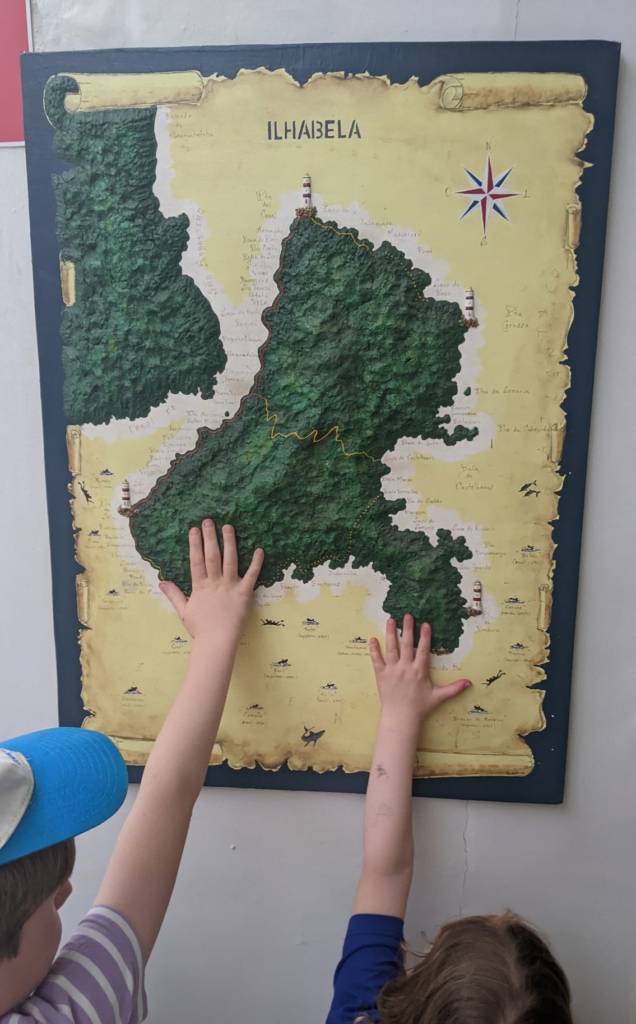
Harry Wood wrote “We arrived at Ilhabela for some Brazil beach time. It’s an island off the Sao Paulo coast. Here’s the kids getting tactile with a relief map in the hotel.”
Looks like fun
MapsintheWild A Tactile Experience in Ilhabela
-
 13:00
13:00 Mappery: 30 Minute Walks in Central London
sur Planet OSGeo
Nick Duggan shared this neat map, not sure where he spotted it.
MapsintheWild 30 Minute Walks in Central London
-
 13:00
13:00 Mappery: Watersnood 4
sur Planet OSGeo -
 13:00
13:00 Mappery: Watersnood 3
sur Planet OSGeo
Via Reinder “This fantastic piece of textile art by Miep van Riessen consists of embroidered names of victims, and is at the same time a quite adequate ‘geographical impression’ of the region where the disaster took place: the Dutch province of Zeeland. “
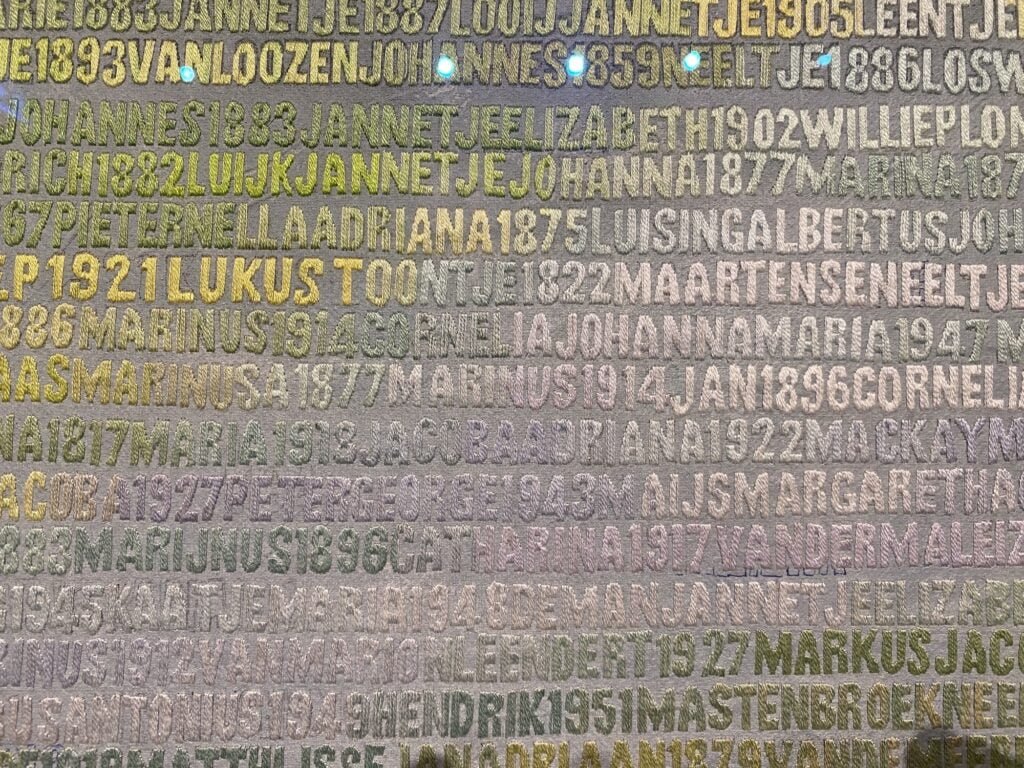
MapsintheWild Watersnood 3
-
 13:00
13:00 Mappery: Watersnood 2
sur Planet OSGeo -
 4:00
4:00 GeoServer Team: Using Binary Comparison Operators in GeoServer Filters
sur Planet OSGeoGeoSpatial Techno is a startup focused on geospatial information that is providing e-learning courses to enhance the knowledge of geospatial information users, students, and other startups. The main approach of this startup is providing quality, valid specialized training in the field of geospatial information.
( YouTube | LinkedIn | Facebook | X )
Binary Comparison Operators in GeoServer FiltersIn this session, we want to talk about the various types of filters, with a particular focus on “Binary comparison operators in GeoServer” comprehensively. If you want to access the complete tutorial, click on the link.
IntroductionFiltering allows the selection of features that satisfy a specific set of conditions. Filters can be used in several contexts in GeoServer:
- In WMS requests, select which features should be displayed on a map
- In WFS requests, specify the features to be returned
- In SLD documents, apply different symbolizations to features on a thematic map
Note. This video was recorded on GeoServer 2.22.4, which is not the most up-to-date version. Currently, versions 2.24.x and 2.25.x are supported. To ensure you have the latest release, please visit this link and avoid using older versions of GeoServer.
Supported filter languagesData filtering in GeoServer follows the OGC Filter Encoding Specification, which provides a standard XML schema for encoding spatial, attribute, and temporal filters in GIS. This allows for customized queries to retrieve specific data from databases and web services while ensuring interoperability among GIS applications. GeoServer supports filters in both Filter Encoding Language and Common Query Language.
Filter Encoding LanguageThe Filter Encoding language, defined by OGC standards, utilizes an XML-based syntax to select specific features, similar to the “WHERE” clause in SQL. A filter consists of a condition formed by Predicate elements and Logical operators, employing comparison and spatial operators to evaluate relationships between feature properties. In this session, we will explore various types of binary comparison operators, while the next sessions will cover spatial operators.
Common Query LanguageCommon Query Language (CQL) is a Text-based language used in GeoServer for constructing filters and queries on geospatial data. It provides flexible and powerful options for filtering and retrieving specific subsets of data from GeoServer layers. In the upcoming sessions, we will dive into a detailed exploration of CQL/ECQL, covering its various operations and practical usage.
Comparison operatorsThese operators are part of Filter Encoding operators and are used in attribute-based queries to filter and retrieve specific features or data, based on their non-spatial attributes. The comparison operators include: binary comparison operators and value comparison operators.
The binary comparison operators are:
- PropertyIsEqualTo
- PropertyIsNotEqualTo
- PropertyIsLessThan
- PropertyIsLessThanOrEqualTo
- PropertyIsGreaterThan
- PropertyIsGreaterThanOrEqualTo
These operators contain two filter expressions to be compared. The first operand is often a
<PropertyName>, but both operands may be any expression, function or literal value. Binary comparison operator elements may include an optional matchCase attribute, with the true or false value. The default value is true, but the comparisons do not check the case if the attribute has a false value.Note. String comparison operators are case-sensitive.
PropertyIsEqualToPropertyIsNotEqualTo is a common type of filter used in GeoServer, which allows you to retrieve features from a data source based on the values of one or more properties. As an example of using this filter in WFS getFeature request:
- Navigate to the Demos page, then select Demo requests.
- From the Request section, select the WFS_getFeature1.0.xml request.
- The address will be filled in automatically, in the URL section.
Use the following block codes to replace line 26:
<PropertyIsEqualTo> <PropertyName>STATE_NAME</PropertyName> <Literal>Delaware</Literal> </PropertyIsEqualTo>- Now, we will explain some elements:
- The first fifteen lines include explanations in the form of comments.
- Line 16 describes the XML version and the GetFeature operation of the WFS service being used.
- Line 17 specifies the default output format for the WFS service as “gml2.” Additionally, GeoServer supports several other commonly used formats such as “gml3, shapefile, geojson, and csv.”
- Lines 18 to 23 define the start of the XML request and declare the namespaces used in the request.
- Line 24 specifies the type name of the feature to be queried. In this case, it requests features of the “topp:states”.
- Lines 25 to 30 define the filter criteria for the query. On these lines, we use the PropertyIsEqualTo filter, to retrieve all features where the state name attribute is equal to
Delaware.
-
Press the Submit button to see the implemented changes.
- Note. For GeoServer 2.25.2 the Demo Request page has been improved to show response Headers, and provide the option to pretty print XML output.
PropertyIsNotEqualTo is another common type of filter used in GeoServer, which allows you to retrieve features from a data source based on properties that don’t match a specified value. As an example of using this filter in a WFS getFeature request, use the following block codes to replace lines 26 to 29:
<PropertyIsNotEqualTo matchCase="false"> <PropertyName>STATE_NAME</PropertyName> <Literal>delAwarE</Literal> </PropertyIsNotEqualTo>Note. The matchCase attribute in WFS_getFeature 1.1 and 2.0 versions, can be set to “false” to specify a case-insensitive comparison.
Press the Submit button.
In this example, we used the
PropertyIsLessThan<PropertyIsNotEqualTo>filter to retrieve all features where theSTATE_NAMEattribute, is not equal toDelaware.The PropertyIsLessThan filter is used to filter features, based on a comparison of a numeric property with a given value. It returns all features where the specified property is less than the specified value.
An example of using this filter in a WFS getFeature request is:
outputFormat="shape-zip" <wfs:Query typeName="topp:states"> <wfs:PropertyName>topp:STATE_NAME</wfs:PropertyName> <wfs:PropertyName>topp:LAND_KM</wfs:PropertyName> <ogc:Filter> <PropertyIsLessThan> <PropertyName>STATE_FIPS</PropertyName> <Literal>18</Literal> </PropertyIsLessThan> </ogc:Filter>Press the Submit button.
In this example, we used the
<PropertyIsLessThan>filter to get all features in a shapefile format where the value of theSTATE_FIPSattribute is less than18. The query only retrieves theSTATE_NAMEandLAND_KMfields, instead of all the attributes.In this session, we took a brief journey through the various types of filters, with a particular focus on “Binary comparison operators in GeoServer”. If you want to access the complete tutorial, simply click on the link.
-
 2:04
2:04 From GIS to Remote Sensing: Semi-Automatic Classification Plugin major update: version 8.3.0
sur Planet OSGeoThe Semi-Automatic Classification Plugin (SCP) has been updated to version 8.3.0.This new version requires Remotior Sensus to be updated to at least version 0.4.0.
During the update process of SCP from version 7 to version 8, several tools were excluded in order to give priority to the main plugin functions.With this 8.3.0 update, several tools are reintroduced, such as Clustering tool for unsupervised classification (K-means method), the Spectral distance tool, the Edit raster tool, and the Raster zonal stats.Read more » -
 14:15
14:15 WhereGroup: Kick-off für die Entwicklung eines bundesweiten Softwaretools für mehr Klimaschutz in der Baubranche
sur Planet OSGeoSchon 2016 waren wir auf Landesebene im Bereich Ersatzbaustoffverordnung tätig und sind nun vom BMUV mit dem Umweltbundesamt mit der Erstellung eines bundesweiten Ersatzbaustoff-Katasters beauftragt. -
 13:42
13:42 GRASS GIS: Report from the GRASS Community Meeting 2024
sur Planet OSGeoThe annual GRASS GIS Community Meeting was held once again in the Czech Republic, this time at the NC State European Center in Prague from June 14 to 19. The meeting brought together users, supporters, contributors, power users and developers to collaborate and chart the future of the project. Thanks to the generous funding from the U.S. National Science Foundation (Award 2303651), the Open Source Geospatial Foundation (OSGeo), FOSSGIS e.V., and individual donors, we were able to welcome 16 in-person participants from 9 countries on 3 continents, plus 2 remote participants. -
 13:00
13:00 Mappery: Watersnood 1
sur Planet OSGeo
Reinder shared this “On the 1st of February 1953 a disastrous flood occurred in the southwest of The Netherlands. More than 1800 people lost their lives and an entire infrastructure was devastated. This is known as the Watersnood, and it is the topic of the Watersnoodmuseum in Ouwerkerk in the province of Zeeland.”
MapsintheWild Watersnood 1
-
 13:00
13:00 Mappery: Custom underwear
sur Planet OSGeo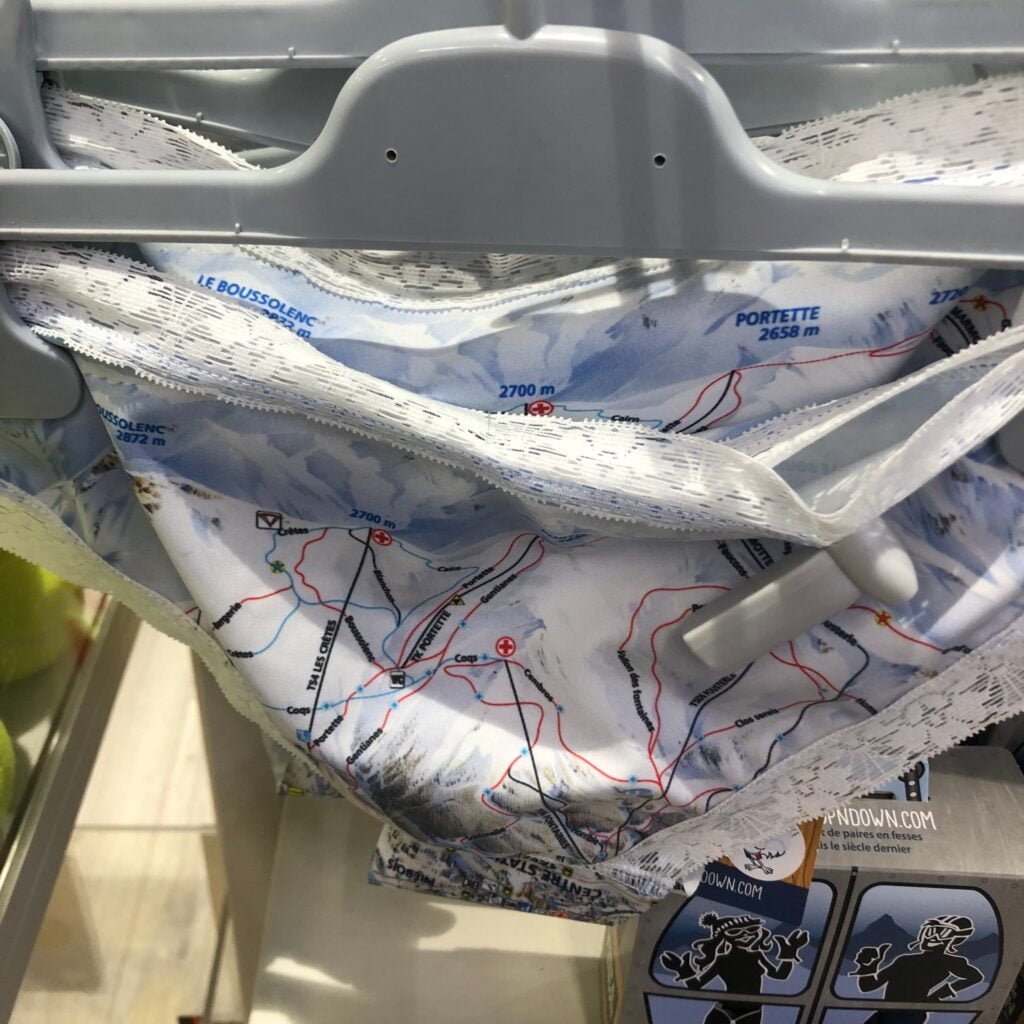
And a new share from LeCatopgrahe with these custom underwear coming from Hop & Down.
MapsintheWild Custom underwear
-
 4:00
4:00 GeoServer Team: GeoServer User Forum replaces mailing list
sur Planet OSGeoGeoServer is updating our communication channels!
We know people do not like signing up for mailing lists, Twitter has been Xed out, and it is time to move on.
GeoServer User ForumWelcome to the GeoServer User forum:
- This forum is open to the public, we are pleased to meet you and hope you enjoy using GeoServer.
- Hosted by Open Source Geospatial Foundation
- All project communication including this forum are subject to our code of conduct
- This is one of many options for community support and communication.
Taking part is easy (sign-in with credentials you already have):
-
Login to discourse.osgeo.org:
-
Login “with LDAP” to use your OSGeo UserID (also used for other osgeo services).
The button appears greyed out, but this is only poor styling choice. The button is enabled and works.
-
Use “Log in with GitHub” to use GitHub credentials.
-
More options are added over time.
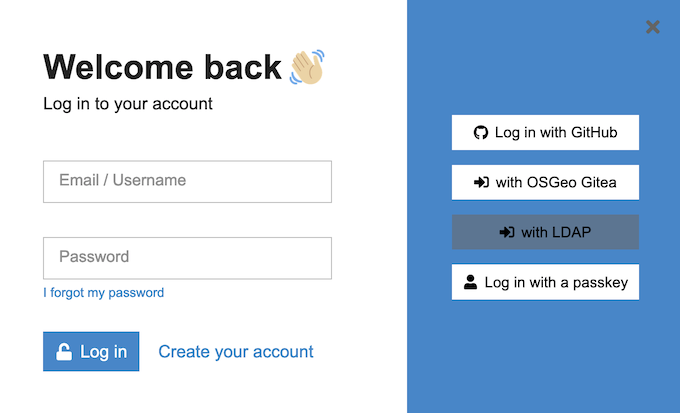
-
-
You may also use “Sign Up” if you want to create an account just for use with the Forum.

-
Unsubscribe from geoserver-users email list.
We will continue to operate the geoserver-user list for the month of August, and then do a final synchronization of any outstanding email messages to complete the migration.
-
Navigate to the category GeoSever / User to enjoy the forum.
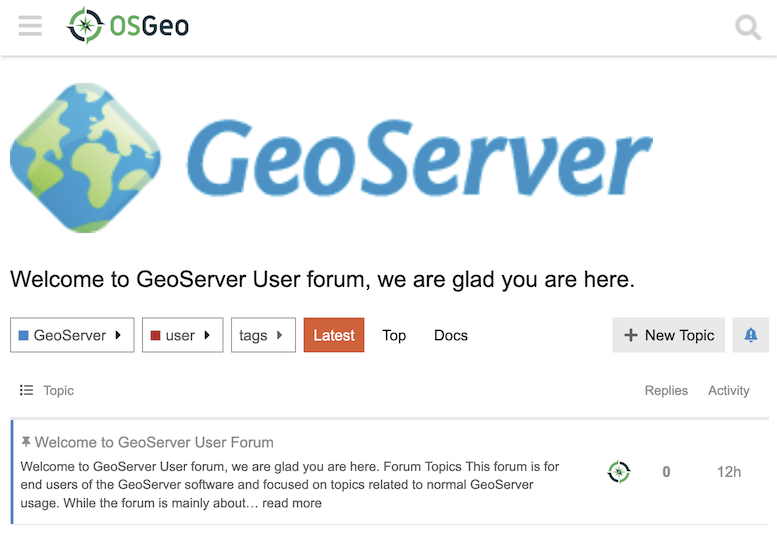
-
Use New Topic to start a new conversation.
Only the
GeoServer / usersubcategory allows new topics. If the New Topic button is disabled you may be looking at theGeoServertop-level category. -
To test please send introduce yourself we are looking forward to meeting you.
If you enjoy the out-of-band timezone friendly mailing list experience - Discourse allows you to subscribe to notifications, and use email to post and reply to topics.
-
Sign-in to Discourse as above.
-
From your profile preferences, use the email tab to adjust email settings.
IMPORTANT: Email is only sent when you are not logged in to the discourse website!
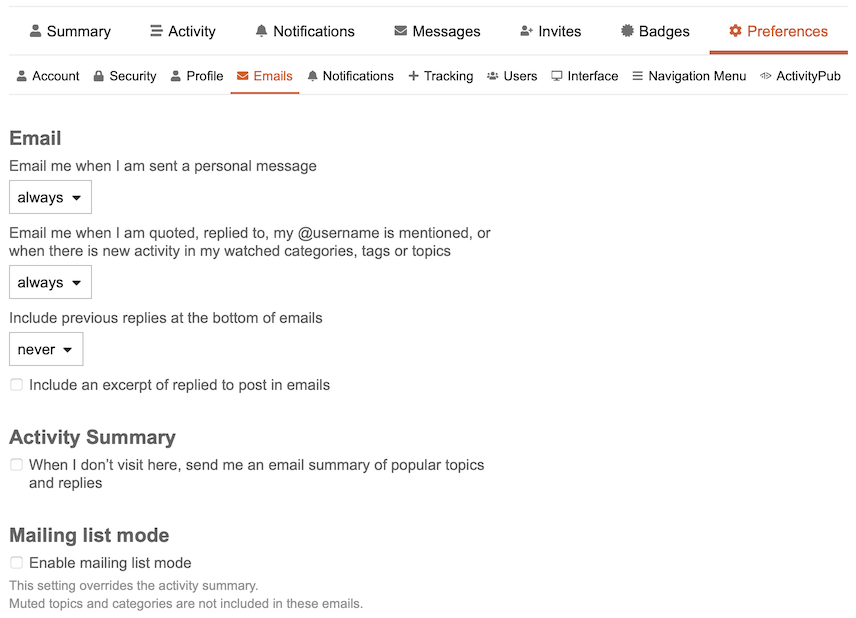
-
Navigate to GeoSever User category, and use the bell to change notifications to Watching.
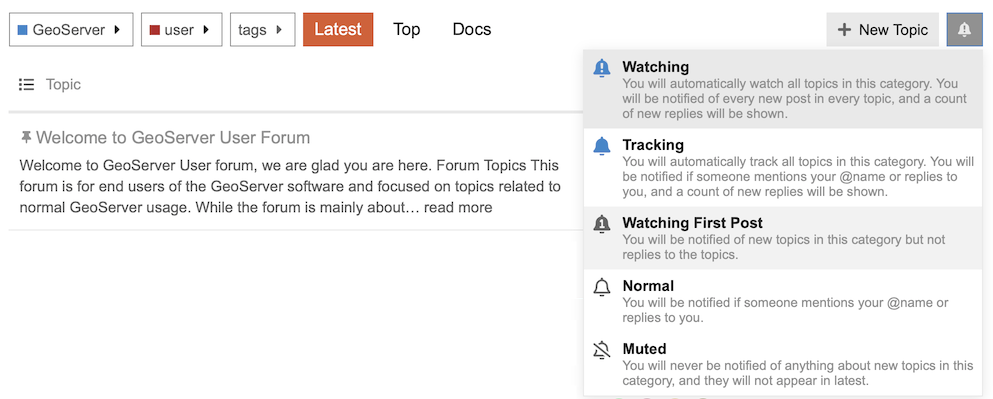
-
If you wish to update any email rules the new mailing is
user.geoserver.discourse.osgeo.org -
You can send email to geoserver-user@discourse.osgeo.org to start a new topic.
To test please send an email to introduce yourself (rather than a test message).
GeoServer is occasionally active on social media:
- Mastadon: @geoserver@fosstodon.org
- LinkedIn Group
- Twitter/X: @GeoServerO - only used for emergencies.
If you enjoy social media we would love some assistance reposting and highlighting our community activity. Contact us on your preferred social media platform to help out.
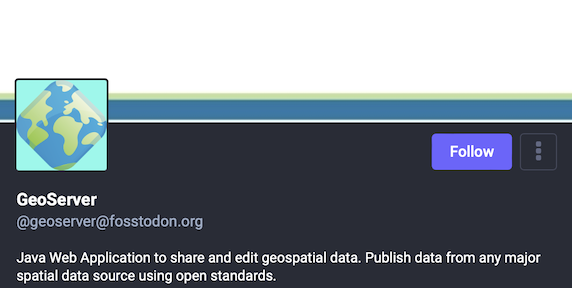
-
 13:00
13:00 Mappery: World T-Shirt
sur Planet OSGeo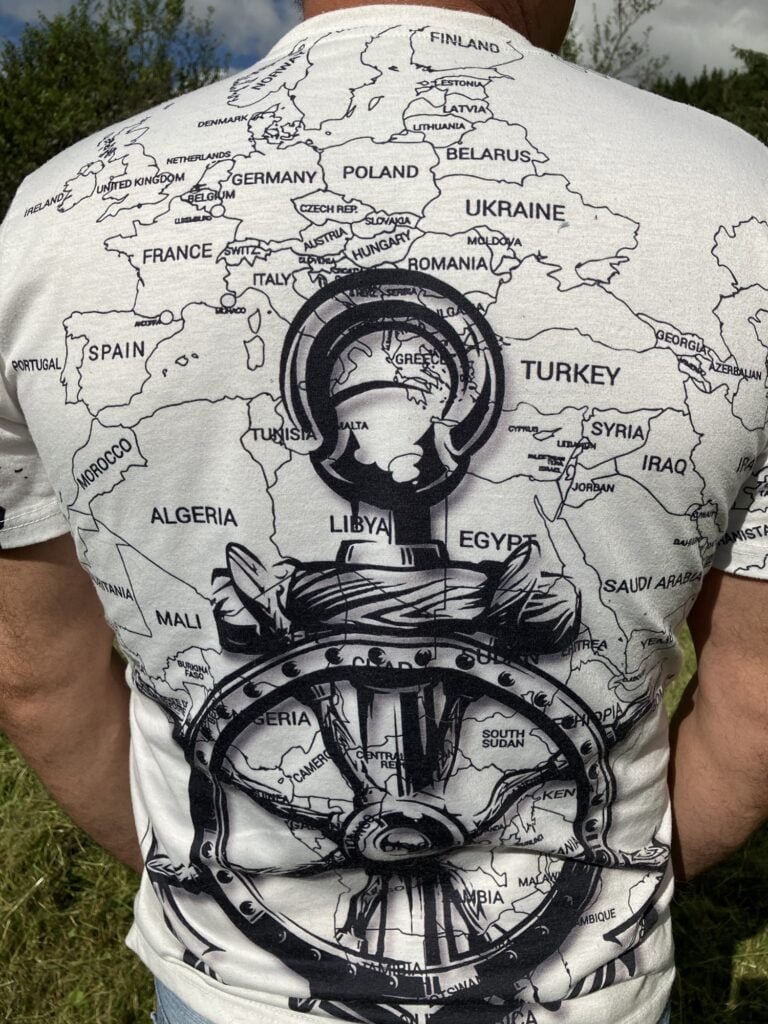
How a mechanical issue leads to a new map in the wild. Back home, I had a problem with a lawn mower. I called a friend for help, who finally came with this fabulous T-shirt!
MapsintheWild World T-Shirt
-
 20:19
20:19 GeoSolutions: GeoSolutions Announces Membership in World Geospatial Industry Council
sur Planet OSGeoYou must be logged into the site to view this content.
-
 13:00
13:00 Mappery: Cup Cakes from Mont-Ral
sur Planet OSGeo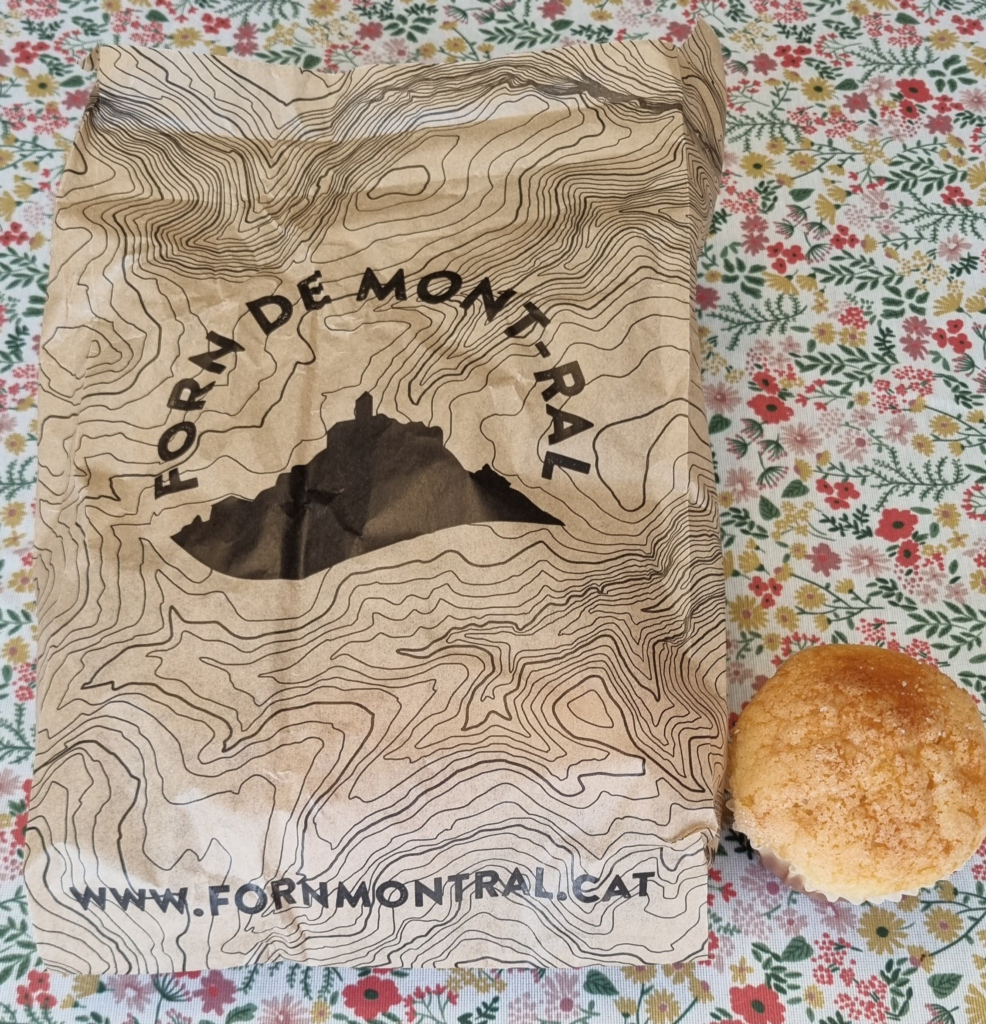
Raf shared this “Tasty cupcakes from Forn de Mont-ral, Prades, Catalunya”
MapsintheWild Cup Cakes from Mont-Ral
-
 13:01
13:01 Markus Neteler: Happy 41st birthday, GRASS GIS!
sur Planet OSGeoToday, we celebrate a true geospatial legend: GRASS GIS!
The post Happy 41st birthday, GRASS GIS! appeared first on Markus Neteler Consulting.
-
 13:00
13:00 Mappery: Panorama of New York City
sur Planet OSGeo
Tom MacWright shared this picture of the Panorama of the City of New York, an urban model of New York City and the centrepiece of the Queens Museum. For more information, click here.
MapsintheWild Panorama of New York City
-
 12:16
12:16 Lettre ouverte à la commission Européenne – Défendons le programme NGI
sur Oslandia
Cette lettre a été publiée initialement par les petites singularités. Si vous souhaitez signer la lettre, vous pouvez la publier sur votre site et compléter le tableau ici.
Le CNLL a également publié une tribune, s’alarmant de la suppression des programmes NGI. Oslandia, en tant que membre du CNLL, soutient aussi ce texte.
Lettre ouverte à la Commission Européenne
 Depuis 2020, les programmes Next Generation Internet (NGI), sous-branche du programme Horizon Europe de la Commission Européenne financent en cascade (via les appels de NLNet) le logiciel libre en Europe. Cette année, à la lecture du brouillon du Programme de Travail de Horizon Europe détaillant les programmes de financement de la commission européenne pour 2025, nous nous apercevons que les programmes Next Generation Internet ne sont plus mentionnés dans le Cluster 4.
Depuis 2020, les programmes Next Generation Internet (NGI), sous-branche du programme Horizon Europe de la Commission Européenne financent en cascade (via les appels de NLNet) le logiciel libre en Europe. Cette année, à la lecture du brouillon du Programme de Travail de Horizon Europe détaillant les programmes de financement de la commission européenne pour 2025, nous nous apercevons que les programmes Next Generation Internet ne sont plus mentionnés dans le Cluster 4.Les programmes NGI ont démontré leur force et leur importance dans le soutien à l’infrastructure logicielle européenne, formant un instrument générique de financement des communs numériques qui doivent être rendus accessibles dans la durée. Nous sommes dans l’incompréhension face à cette transformation, d’autant plus que le fonctionnement de NGI est efficace et économique puisqu’il soutient l’ensemble des projets de logiciel libre des plus petites initiatives aux mieux assises. La diversité de cet écosystème fait la grande force de l’innovation technologique européenne et le maintien de l’initiative NGI pour former un soutien structurel à ces projets logiciels, qui sont au cœur de l’innovation mondiale, permet de garantir la souveraineté d’une infrastructure européenne. Contrairement à la perception courante, les innovations techniques sont issues des communautés de programmeurs européens plutôt que nord-américains, et le plus souvent issues de structures de taille réduite.
Le Cluster 4 allouait 27.00 millions d’euros au service de :
- « Human centric Internet aligned with values and principles commonly shared in Europe » ;
- « A flourishing internet, based on common building blocks created within NGI, that enables better control of our digital life » ;
- « A structured eco-system of talented contributors driving the creation of new internet commons and the evolution of existing internet common ».
Au nom de ces enjeux, ce sont plus de 500 projets qui ont reçu un financement NGI0 dans les 5 premières années d’exercice, ainsi que plus de 18 organisations collaborant à faire vivre ces consortia européens.
NGI contribue à un vaste écosystème puisque la plupart du budget est dévolue au financement de tierces parties par le biais des appels ouverts (open calls). Ils structurent des communs qui recouvrent l’ensemble de l’Internet, du matériel aux applications d’intégration verticale en passant par la virtualisation, les protocoles, les systèmes d’exploitation, les identités électroniques ou la supervision du trafic de données. Ce financement des tierces parties n’est pas renouvelé dans le programme actuel, ce qui laissera de nombreux projets sans ressources adéquates pour la recherche et l’innovation en Europe.
Par ailleurs, NGI permet des échanges et des collaborations à travers tous les pays de la zone euro et aussi avec ceux des widening countries [1], ce qui est actuellement une réussite tout autant qu’un progrès en cours, comme le fut le programme Erasmus avant nous. NGI0 est aussi une initiative qui participe à l’ouverture et à l’entretien de relation sur un temps plus long que les financements de projets. NGI encourage également à l’implémentation des projets financés par le biais de pilotes, et soutient la collaboration au sein des initiatives, ainsi que l’identification et la réutilisation d’éléments communs au travers des projets, l’interopérabilité notament des systèmes d’identification, et la mise en place de modèles de développement intégrant les autres sources de financements aux différentes échelles en Europe.
Alors que les États-Unis d’Amérique, la Chine ou la Russie déploient des moyens publics et privés colossaux pour développer des logiciels et infrastructures captant massivement les données des consommateurs, l’Union Européenne ne peut pas se permettre ce renoncement. Les logiciels libres et open source tels que soutenus par les projets NGI depuis 2020 sont, par construction, à l’opposée des potentiels vecteurs d’ingérence étrangère. Ils permettent de conserver localement les données et de favoriser une économie et des savoirs-faire à l’échelle communautaire, tout en permettant à la fois une collaboration internationale. Ceci est d’autant plus indispensable dans le contexte géopolitique que nous connaissons actuellement. L’enjeu de la souveraineté technologique y est prépondérant et le logiciel libre permet d’y répondre sans renier la nécessité d’œuvrer pour la paix et la citoyenneté dans l’ensemble du monde numérique.
Dans ces perspectives, nous vous demandons urgemment de réclamer la préservation du programme NGI dans le programme de financement 2025.
[1] Tels que définis par Horizon Europe, les États Membres élargis sont la Bulgarie, la Croatie, Chypre, la République Tchèque, l’Estonie, la Grèce, la Hongrie, la Lettonie, la Lithuanie, Malte, la Pologne, le Portugal, la Roumanie, la Slovaquie et la Slovénie. Les pays associés élargies (sous conditions d’un accord d’association) l’Albanie, l’Arménie, la Bosnie Herzégovine, les Iles Feroé, la Géorgie, le Kosovo, la Moldavie, le Monténégro, le Maroc, la Macédoine du Nord, la Serbie, la Tunisie, la Turquie et l’Ukraine. Les régions élargies d’outre-mer sont : la Guadeloupe, la Guyane Française, la Martinique, La Réunion, Mayotte, Saint-Martin, Les Açores, Madère, les Iles Canaries.Photo de Maximalfocus sur Unsplash
-
 13:00
13:00 Mappery: Sorgenfri
sur Planet OSGeo -
 13:42
13:42 GRASS GIS: GRASS GIS 8.4.0 released
sur Planet OSGeoWhat’s new in a nutshell The GRASS GIS 8.4.0 release contains more than 520 changes compared to 8.3.2. This new minor release includes important fixes and improvements to the GRASS GIS tools, libraries and the graphical user interface (GUI), making it even more stable and robust for daily work. Most importantly: location becomes project: The Python API, command line, and graphical user interface are now using project instead of location for the main component of the data hiearchy while maintaining backward compatibility. -
 13:00
13:00 Mappery: Bed sheets
sur Planet OSGeo -
 13:00
13:00 Mappery: Do not mix dishcloths and napkins
sur Planet OSGeo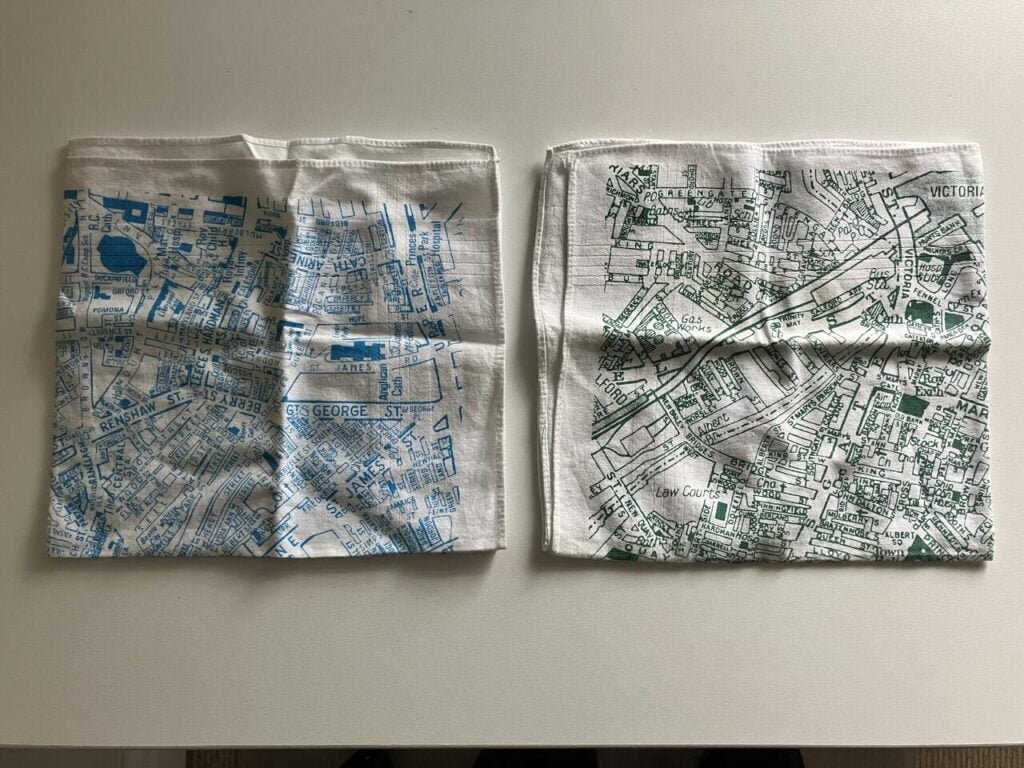
This is literally what I thought when I saw this picture. The sentence makes sense for a French speaker; the English version would be: not mix apples and pears, but I also found apples and oranges. Always happy to learn the usage if you want to comment on our socials.
Anyway, my title is misleading about the subject; the picture shows handkerchiefs from Chris Chambers.
MapsintheWild Do not mix dishcloths and napkins
-
 13:00
13:00 Mappery: Bowtie
sur Planet OSGeo -
 11:07
11:07 GeoSolutions: MapStore 2024.01 Series of releases
sur Planet OSGeoYou must be logged into the site to view this content.
-
 8:49
8:49 GéoDataDays 2024
sur Oslandia
Oslandia est cette année encore sponsor des GéoDataDays qui se tiendront les 19 et 20 septembre 2024 à Nantes ! Retrouvez-nous sur notre stand pour découvrir nos solutions et notamment Piero, l’application Web 3D SIG/BIM open source et sur l’espace Démo pour un atelier Métropoles
 OpenSource !
OpenSource !Venez discuter des dernières avancées de l’open source Geospatial, voir les projets que nous avons réalisés, et découvrir comment nous pouvons répondre à vos problématiques.
Vous y croiserez notamment Bertrand Parpoil, Vincent Picavet, Julien Moura et Vincent Bré !
Inscription : [https:]]
-
 15:40
15:40 WhereGroup: Erweiterte Geodatenvisualisierung mit MapComponents
sur Planet OSGeoDie MapComponents-Bibliothek ermöglicht die Anzeige und Integration verschiedener Datenformate direkt im Browser. Anhand eines praktischen Beispiels wird gezeigt, wie Benutzer OpenStreetMap-Daten in eine Webanwendung laden und diese anzeigen lassen können. -
 13:00
13:00 Mappery: Coaster
sur Planet OSGeo -
 13:15
13:15 Jorge Sanz: Elastic Volunteering Time Off
sur Planet OSGeo
My employer, Elastic, has a number of philanthropic initiatives but definitely the one I love the most is the Volunteering Time Off (VTO). We are given 40 hours per year from our working hours to contribute to projects and initiatives we care about. Employees have full freedom to choose what they want to do with that time and are encouraged to use it.
In my case, over this almost 5 years I have to admit I haven’t used all that time every year but I tried to get the most of it. During COVID I did some remote work for a local NGO that works for fair trade, giving them a webinar about Open Source among other things (see update from December 2019 and following months). I also spent a few days working on some admin tasks for the Open Source Geospatial Foundation and I’ve already written here about a couple sessions I did for Cibervoluntarios, training seniors and teens about safe browsing and email.
Last week I was showcased in the company blog, along with other colleagues, on different projects to contribute to. In my case, last year I joined the mapping efforts after the Morocco Earthquake and took a full day mapping roads and streets of a rural area, as part of the coordinated efforts from the Humanitarian OpenStreetMap team (reported on my October community update). I’m very happy to have this support from my employer to leave things aside when an emergency like this arises, granted there are no other urgent issues at work.
As a personal call to action, I’d love to get back to Cibervoluntarios activities. This year has been quite busy; let’s see after summer if there’s room for getting out and engaging with them.
I know I haven’t updated this site in a while, I’ll write one soon! ?
-
 13:00
13:00 Mappery: Geodesic point
sur Planet OSGeo -
 11:00
11:00 QGIS Blog: Introducing the new QGIS.org website
sur Planet OSGeoWe have a new website!
We recently launched our new website at QGIS.org. It is a ground-up overhaul and provides a fresh take on the first contact point for existing or potential users wishing to engage with the QGIS project and discover its value proposition.

A new strategy for QGIS.org websites
In this blog post, we would like to provide an overview of the goals that we had for building the new QGIS.org website and the bigger picture of how this website update fits into the broader strategy for our website plans for QGIS.
About two years ago, we started experimenting with building a new QGIS.org website based on Hugo. Hugo, as a technology choice, was less important than was our intent to develop a more modern site that addressed our strategic goals.
After some ‘in-house’ (i.e. volunteer-based) work to develop an initial version of the site, we received the go-ahead to use QGIS funds for this and put out a call in October 2023 for a company to support our work. This was ultimately won by Kontur.io, who, together with our volunteers, brought the work into high gear.
 Initial analysis of the questions and actions to be quickly answered by qgis.org
Initial analysis of the questions and actions to be quickly answered by qgis.org
Goal 1: Speak to a new audience
Our primary goal was to speak to a new audience. We are confident that QGIS can compete with all of the commercial vendors providing GIS software. We didn’t convey that well on our old website. We feel that QGIS was too apologetic in how it presented itself. We wanted a website which inspires confidence while addressing the needs of a corporate or organisational decision-maker who is looking at the QGIS project during their GIS software selection process.
The old website was very focused on the developer and contributor community. Obviously, those aspects are important since, without our fantastic community, the QGIS project would not exist. The messaging around open source is also important. Yet these ideas are secondary to the idea that QGIS is one of the best (if not the best) desktop GIS applications out there on the market – open-source or otherwise. We need to present it in this professional perspective.
So, the first goal was to change the messaging to focus on QGIS’s value proposition and take a very professional approach to presenting ourselves on the website.
 User group and requirements analysis for the potential qgis.org visitors
User group and requirements analysis for the potential qgis.org visitors
Goal 2: Harmonisation
The second goal was to start the process of harmonising all of our website properties. QGIS.org, over the years, has built many different web properties. For example, there’s the plugins website, the feed, the changelog, the sustaining members website, the lessons website and the certification website, the new resources hub website, the API documentation, the user documentation, the user manual, the training manual, various other documentation efforts, and more. Some of those are combined in one application, There are also some less well-known resources, like our analytics.qgis.org and another one for plugin analytics. In short, we’ve a lot of resources!
With so many different web properties, they’ve devolved over time: each has its own look and feel, navigation approach and how you interact with it. Some of them were translated, and some of them were not. We want to harmonise all of these sites so that the user does not notice any change in user experience when they move from one QGIS-related site to another.
Goal 3: Harmonising deployment
In the underlying process of these changes, we’re also redeploying all of the websites on new servers, which are more up-to-date and use better security and maintenance practices. Plenty of work is happening in the background to ensure that all of the servers are in a better-maintained state, document how they’re maintained, and so on.
Goal 4: A hub and spokes
The objective of the new site design is to allow quick movement between the QGIS auxiliary sites. The QGIS.org site will form a hub that effortlessly takes visitors to whichever QGIS-related site they need to complete the task they are busy with. If you’re moving between these sites, the experience should be seamless. You should not really even be aware that you’re moving between different websites. Other than looking at the URL bar, the user presentation and experience should be harmonious between all of them.
One way we are planning to achieve this is to have a universal menu bar and footer. You will see that in the new website’s design, there is a menu bar across the top. This menu bar has two levels: the top menu and the second level, where the search bar is.
 The universal menu bar
The universal menu bar
In this second row, auxiliary sites will have their own sub-menu whilst keeping the shared top-level menu. So if you, for example, are moving around in plugins and want to review the plugin list or submit a new plugin, all of that navigation will be on the second line where the search bar is currently. Regardless of which subdomain you are on, the top-level menu bar will be the same, allowing you to easily navigate back to the hub or to another subdomain.
The footer will be unified and shared between all sites, and the cascading style sheets and styling will be unified across all of the QGIS websites.
In the next phase, we will work to achieve this coherence across all the websites, though we still have a few more tweaks to make to the qgis.org site first.
Goal 5: DOTDOTW – do one thing, do one thing well
We plan to break some auxiliary websites apart into separate pieces. So, for example, the changelog management, certification management, sustaining members management, and lessons management are all in one Django app. We will split them into small single-purpose applications using some common UX metaphors so that each is a standalone application that makes it easy for a potential contributor to understand everything the application does. This will also simplify management as we can upgrade each auxiliary site on separate development cycles. We will also finally have semantic URLs, e.g. certification.qgis.org, to take you to the different areas of interest on the site.
The plugins.qgis.org is also going to be refactored so that it just has plugins and not the resource sharing we’ve added in the last few years. The resource sharing will go into its own subdomain. Similarly, the Planet website will get split into its own website (the planet is a blog aggregator or RSS aggregator) that will be in its own managed instance. Some other components (like the analytics) are difficult to split out like this because they’re linked to the same database. We will try to make sure that those are more discoverable and theme them as much as possible to match the rest of the website experience.
Goal 7: Encapsulation

Another goal we had for the QGIS.org makeover was to make the site performant and self-contained. By self-contained, we mean that it should not ‘call’ out to CDN, Google or other platforms for resources like fonts, CSS frameworks, javascript libraries, etc. There were two reasons for this:
- These platforms often use such resources to track users as they move around the Internet, which we want to avoid as much as possible.
- We want to wholly manage our site, be able to fix any issues independently and generally follow a path of self-determination.
Our approach also facilitated the creation of a very performant website, as you can see here. We will try to adhere to these principles for the auxiliary site updates we do in the future, too.
What about translations?The question has come up: Why did we not want to translate the new QGIS.org when it was translated before?
Firstly, we should make it clear that we do not plan to remove translations from the user documentation, the user manual, and so on, where we think they have the most value.
For the main QGIS.org site, we question whether there is a high value in translating it. Here are some reasons why:
1. Lingua franca: If you are an IT manager in a non-English-speaking country and you want to evaluate some software, you’re going to run into a product page that presents itself in English – it is the norm for IT procurement to work in English for reviewing software products and so on.
2. Automation: Automated translations inside browsers are getting better and better. While these translations are still not completely adequate, we think they will be in one or two years’ time.
3. Translation integrity: Our pursuit of Goal 1 means that we would no longer find it acceptable to have partial website translations. We also need to ensure that the wording and phrasing are consistent with the English messaging. We also have concerns about the QA process regarding trust and review – we want to ensure that any translation truly reflects the meaning and intent of the original content and has not been adjusted during the translation process.
4. Cohesion: Our most important point is raised if we go back to this idea of cohesion between the different websites like QGIS.org, plugins.qgis.org and so on. As well as having the same styling, we also don’t want to switch between languages as you hop between the sites. We aim to present them all as one site. If we translate QGIS.org and then take you to our auxiliary sites, e.g., plugins.qgis.org, the feed, or certification pages, which are in English only, the experience is jarring.
So we must either translate everything into all of the same languages, or work in English. Translating everything is a mammoth task for the translators and for us to retrospectively add translation support to each platform. Thus, we prefer the approach of harmonising everything to one language and then focusing our translation efforts on three areas:
- The application itself,
- the user manual and
- the training manuals.
We can leave the rest of the experience in English and instead focus on harmonising, for now, both in terms of look and feel and the technology used.
When we consider everything as one big website and what the bigger plan is, it is hopefully clearer why we didn’t think translating the landing page and QGIS.org was the best approach.
Further funded workWe hope to use more QGIS funding to support this work in the future. We’re also hoping to work again with Kontur to start moving all these auxiliary sites into their own projects, applying our style guidelines to each. Independently of that, Tim (volunteer), Lova (QGIS funded), and others are already getting started with this process.
Helping outDo you have strong opinions about the website? Contact Tim on the PSC mailing list if you would like to get involved as a volunteer. We would love to hear from designers, word smiths, marketers, information architects, SEO specialists, web developers and those who think they can help us achieve our goals.
ConclusionWe hope our goals and process make sense for everybody and that we were able to lay out a clear, logical argument about why we don’t want to translate the new website quite yet. We want to focus on these overarching goals and then return to them later if they are still a priority for people. Everything we have built is Open Source and available at this repo, where you can also find an issue tracker to report issues and share ideas relating to the new website.
Thanks for reading. Go spatial without compromise


Cheers, Tim, Marco and Anita
-
 8:55
8:55 [1’Tech by Oslandia] open data
sur OslandiaDans cette minute Tech, nos collaborateurs vous proposent d’expliquer une technologie, une méthodologie, un concept. Après open source, LiDAR, webGL, réversibilité, TCO et même télétravail, on a brainstormé sur GitLab pour donner notre meilleure définition de l’open data
L’open data ( « Donnée ouverte » ), est la donnée librement accessible. Elle concerne notamment toutes les données publiques accessibles aux usagers : citoyens, entreprises, collectivités, … Elles peuvent être d’origine privée mais sont la plupart du temps mises à disposition par une collectivité ou un établissement public.
L’Open Knowledge Foundation en 2005 donnent les critères essentiels de l’open data : la disponibilité, la réutilisation et la distribution, et la participation universelle. En France, il existe un cadre légal obligeant à l’ouverture de certaines données.
Ces ressources ouvertes accessibles dans des catalogues de données, permettent de construire des outils comme des observatoires pour lesquels la représentation cartographique est utilisée.Oslandia a travaillé sur de nombreux projets mobilisant de l’open data, c’est le cas de Terristory®, un outil partenarial d’aide au pilotage de la transition des territoires ou sur des projets avec Bruxelles Environnement. Nous avons également une connaissance approfondie de la donnée OpenStreetMap.
L’open data permet d’alimenter ces outils numériques avec de la donnée de qualité permettant ainsi des services de qualité.
OpenData et OpenSource forment le combo libre et efficient !
-
 4:00
4:00 SourcePole: Adding external WMS to the QGIS Cloud Web Map
sur Planet OSGeoThe use of WMS/WMTS layers in a QGIS Cloud map project can significantly degrade the performance of the map display. I have already discussed how to counter this problem in an earlier post. One of the solutions is to load external WMS as background layers. The problem with this approach, however, is that only one WMS background layer can be loaded at a time. If further WMS layers are to be loaded into the map at the same time, this approach cannot be used. -
 13:00
13:00 Mappery: Wallpaper
sur Planet OSGeo -
 4:00
4:00 GeoServer Team: GeoServer 2024 Q3 Developer Update
sur Planet OSGeoThis is a follow up to 2024 roadmap post outlining development opportunities.
First of all thanks to developers and organisations that have responded with offers of in-kind contributions. This blog post is assessing current progress and outlines a way forward to complete the Java 17/Jakarta EE/Spring 6 upgrades.
This post highlights development activities that are available to be worked on today, along with interested developers and commercial support providers available to work on GeoServer roadmap items.
Spring Framework 6 TasksThe key challenge we are building towards is a spring-framework 6 update, ideally by the end of 2024 when the version we use now reaches end-of-life.
The tasks below are steps towards this goal.
Wicket 9 upgradeInterested Parties:
- Brad has been doing amazing work with the Wicket 9 upgrade and is in need of assistance.
- GeoCat has offered to do manual A/B testing when PR is ready for testing.
Activity:
- [GEOS-11275] Wicket 9 upgrade
- geoserver#7154
Spring Security 5.8 provides a safe stepping stone ahead of the complete spring-framework 6 upgrade and is an activity that can be worked on immediately.
Interested parties:
- Andreas Watermeyer (ITS Digital Solutions) offered to work on this activity in during the initial January call out, and has indicated they are now ready to start.
Activity:
- [GEOS-11271] Upgrade spring-security to 5.8
The spring-security-oauth client has reached end-of-life and a GeoServer OAuth2 support must be rewritten or migrated as a result.
There are two paths to migrate to spring-security-core implementation:
-
Option: Migrate the existing community module implementations to spring-security-core in place; with as little loss of functionality as possible. This has the advantage of using existing test coverage to maintain a consistent set of functionality during migration.
-
Option: Setup a community module alongside the existing implementation with the goal of making a full supported etension. This approach has the advantages of allowing organisations the ability to do A/B testing as both the old and new implementation would be available alongside each other. This has the advantage of allowing stakeholders to only fund, implement, test functionality as required without disrupting existing use.
Security integrations often require infrastructure to develop and test against, which the core GeoServer team does not have access to for automated tests. We would like to see organisations review their security integration requirements and be on hand to support this development activity.
The initial priority will support for OAuth2 and Open ID Connect (OIDC), parties interested in maintaining support for Google, GeoNode, GitHub are welcome to participate.
Interested Parties:
- Andreas Watermeyer (ITS Digital Solutions) offered to work on this activity, or test as needed.
- GeoCat is interested in this work also, with the goal of bringing the OIDC plugin up to full extension status (if financing is available).
Activity: not started
- [GEOS-11272] spring-security-oauth replacement, with spring-security 5.8
The image processing library used by GeoServer has been donated to the open source community under the name ImageN.
The immediate goal has been to add test cases to this codebase and make an ImageN 1.0 release. Andrea has come up with the amazing idea of integrating with JAI-Ext project immediately, to benefit from the improved operators, and jumpstart test coverage.
Interested Parties:
- Jody (GeoCat) is available to support this activity, or take lead if funding is available.
- Andrea (GeoSolutions) has had a deep dive into the implications for the JAI-EXT project outlining a roadmap for project integration
We would like to see organisations that depend on GeoServer for earth observation and imagery to step forward with funding for this activity.
2024 Financial support and sponsorshipThus far 2024 has not had a strong enough sponsorship response to support the project goals above. As a point of comparison we established a budget of $15,000 with OSGeo last year to take on an low-level API change that affected several projects.
This year GeoServer sponsorship has raised between $1,000 and $2,000 which is not enough to plan with or coordinate in-kind contributions offered thus far.
Jody has worked with the OSGeo board to make adjustments to the sponsorship:
- Guidance has been provided for appropriate sponsorship levels for individual consultants, small organisation, companies and public institutions of different sizes.
- There are clear examples of how to sponsor and donate, along with the the perks and publicity associated with financial support
- GeoServer has a new sponsorship page on our website collecting this information
- GeoServer now lists sponsors logos on our home page, alongside core contributors.
We would like to thank everyone who has responded thus far:
- Sponsors: How 2 Map, illustreets
- Individual Donations: Peter Rushforth, Marco Lucarelli, Gabriel Roldan, Jody Garnett, Manuel Timita, Andrea Aime
-
 15:00
15:00 From GIS to Remote Sensing: Semi-Automatic Classification Plugin version 8.3 release date
sur Planet OSGeoThis post is to announce that the new version 8.3 of the Semi-Automatic Classification Plugin (SCP) for QGIS will be released the 3rd of August 2024.This new version will require the new version 0.4 of the Python processing framework Remotior Sensus, and will include several new features such as such as clustering, raster editing and raster zonal stats.
For any comment or question, join the Facebook group or GitHub discussions about the Semi-Automatic Classification Plugin.
-
 13:00
13:00 Mappery: Which projection is this?
sur Planet OSGeo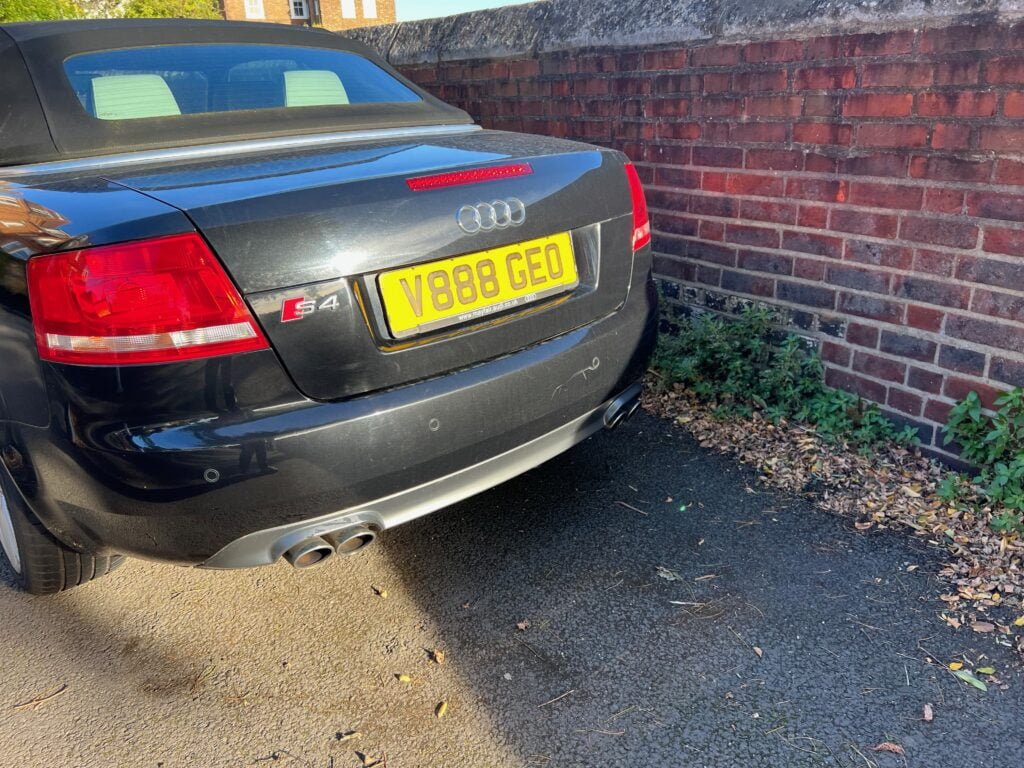
I found this nice geo license plate walking by the River Thames. Very geo-nerdy. Happy Sunday!
MapsintheWild Which projection is this?
-
 17:41
17:41 From GIS to Remote Sensing: Remotior Sensus Update: Version 0.4
sur Planet OSGeo I'm glad to announce the update of Remotior Sensus to version 0.4.This new version add several new features such as clustering, raster editing and raster zonal stats. Following the complete changelog:
I'm glad to announce the update of Remotior Sensus to version 0.4.This new version add several new features such as clustering, raster editing and raster zonal stats. Following the complete changelog:- Added tool "Band clustering" for unsupervised K-means classification of bandset
- Added tool "Raster edit" for direct editing of pixel values based on vector
- Added tool "Raster zonal stats" for calculating statistics of a raster intersecting a vector.
- Improved the NoData handling for multiprocess calculation
- In "Band clip", "Band dilation", "Band erosion", "Band sieve", "Band neighbor", "Band resample" added the option multiple_resolution to keep original resolution of individual rasters, or use the resolution of the first raster for all the bands
- In "Cross classification" fixed area based accuracy and added kappa hat metric
- In "Band combination" added option no_raster_output to avoid the creation of output raster, producing only the table of combinations
- In "Band calc" replaced nanpercentile with optimized calculation function
- Improved extraction of ROIs in "Band classification"
- Minor bug fixing and removed Requests dependency
-
 13:00
13:00 Mappery: Corsica
sur Planet OSGeo -
 19:43
19:43 GeoNode: Docs For Devs
sur Planet OSGeoGeoNode: Docs For Devs -
 19:43
19:43 GeoNode: Translate
sur Planet OSGeoGeoNode: Translate -
 19:43
19:43 GeoNode: Improve
sur Planet OSGeoGeoNode: Improve -
 19:43
19:43 GeoNode: Future
sur Planet OSGeoGeoNode: Future -
 19:43
19:43 GeoNode: Patches
sur Planet OSGeoGeoNode: Patches -
 19:43
19:43 GeoNode: Contribute
sur Planet OSGeoGeoNode: Contribute -
 19:43
19:43 GeoNode: Extend
sur Planet OSGeoGeoNode: Extend -
 19:43
19:43 GeoNode: Arch
sur Planet OSGeoGeoNode: Arch -
 19:43
19:43 GeoNode: Testing
sur Planet OSGeoGeoNode: Testing -
 19:43
19:43 GeoNode: Env Dev
sur Planet OSGeoGeoNode: Env Dev -
 19:43
19:43 GeoNode: Management Commands
sur Planet OSGeoGeoNode: Management Commands -
 19:43
19:43 GeoNode: Backups
sur Planet OSGeoGeoNode: Backups -
 19:43
19:43 GeoNode: Other Languages
sur Planet OSGeoGeoNode: Other Languages -
 19:43
19:43 GeoNode: Ssl
sur Planet OSGeoGeoNode: Ssl -
 19:43
19:43 GeoNode: Troubleshoot
sur Planet OSGeoGeoNode: Troubleshoot -
 19:43
19:43 GeoNode: Customize Geonode
sur Planet OSGeoGeoNode: Customize Geonode -
 19:43
19:43 GeoNode: Production Geonode
sur Planet OSGeoGeoNode: Production Geonode -
 19:43
19:43 GeoNode: Install Geonode
sur Planet OSGeoGeoNode: Install Geonode -
 19:43
19:43 GeoNode: Share Map
sur Planet OSGeoGeoNode: Share Map -
 19:43
19:43 GeoNode: Find Map
sur Planet OSGeoGeoNode: Find Map -
 19:43
19:43 GeoNode: Create Map
sur Planet OSGeoGeoNode: Create Map -
 19:43
19:43 GeoNode: Add Data
sur Planet OSGeoGeoNode: Add Data -
 19:43
19:43 GeoNode: New Account
sur Planet OSGeoGeoNode: New Account -
 19:43
19:43 GeoNode: Tutorials
sur Planet OSGeoGeoNode: Tutorials -
 16:27
16:27 GeoTools Team: GeoTools 31.3 released
sur Planet OSGeo GeoTools 31.3 released The GeoTools team is pleased to announce the release of the latest maintenance version of GeoTools 31.3: geotools-31.3-bin.zip geotools-31.3-doc.zip geotools-31.3-userguide.zip geotools-31.3-project.zip This release is also available from the OSGeo Maven Repository and is made in conjunction with GeoServer 2.25.3 We -
 15:17
15:17 Adam Steer: Mapping a small farm part 3: using an aerial orthophoto
sur Planet OSGeoPart 1 of this series looked at how to fly drones and collect imagery for mapping over a small property. Part 2 showed use cases for a digital elevation model. This story focusses on the georeferenced imagery produced in the process. It will look at three use cases – and explain some of the limitations:… Read More »Mapping a small farm part 3: using an aerial orthophoto -
 13:00
13:00 Mappery: Armchair
sur Planet OSGeo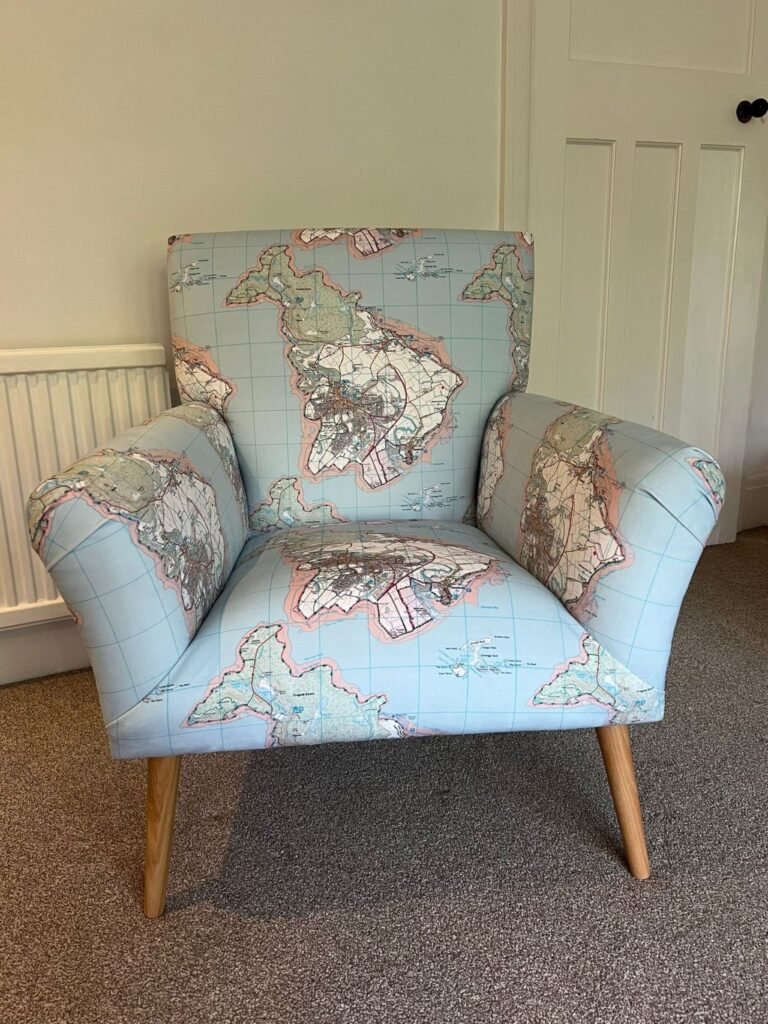

It is a bit unusual, but we found this one on LinkedIn. Chris Chambers received this armchair as a birthday gift.
MapsintheWild Armchair
-
 4:00
4:00 Camptocamp: Optimizing Trail Management: Mergin Maps for Greater Annecy
sur Planet OSGeoPièce jointe: [télécharger]
Grand Annecy turned to Camptocamp to find the tool best suited to their needs.
-
 9:30
9:30 [Équipe Oslandia] Jean-Marie, développeur C++ / Python
sur OslandiaJean-Marie a toujours aimé l’électronique et tout ce qui touche au traitement du signal. Il rejoint l’INSA Rennes, une école d’ingénieur généraliste en spécialité ESC – Electronique et Systèmes de Communication (aujourd’hui E&T) sur les problématiques télécommunications.
Il réalise son stage de fin d’étude chez Silicom à Rennes sur le sujet « Modélisation de systèmes de communication » sous Matlab avant d’être embauché par la même entreprise mais pour une toute autre mission …le développement d’une application informatique de simulation de réseaux télécom pour la DGA avec QT en C++ !
« Je ne connaissais pas trop l’informatique, quelques notions pendant mes études, mais j’aimais bien, ça me plaisait de pouvoir me lancer là dedans. J’ai acquis des connaissances en pratiquant, c’est comme ça qu’on apprend ! »
Ensuite, Jean-Marie saisit l’opportunité de travailler sur le passage au tout numérique via la TNT. « J’ai travaillé pendant 2 ans et demi au CSA, j’ai réalisé des études sur la planification de fréquences, étudié les couvertures des émetteurs TNT. C’était une super expérience, j’ai travaillé sur un projet qui a impacté les français au quotidien ! »
De retour à Rennes, il reprend le développement en C++ avec QT, notamment pour un projet d’analyse de signaux sismiques du CEA et découvre QGIS. Une nouvelle compétence qu’il mobilise pour la DGA et le développement d’un outil basé sur QGIS pour l’affichage de données relatives à l’aide à la planification de missions satellites.
« 14 ans chez Silicom, il était temps de passer à autre chose »
Jean-Marie rejoint Oslandia en novembre 2021 en tant que développeur C++ / Python où il réalise des missions de développement et DevOps, notamment pour Viamichelin sur la refonte du calcul d’itinéraire de l’outil en ligne ou pour l’IGN pour la mise en place du calcul d’itinéraire sur la nouvelle Géoplateforme.
Projet emblématiqueJean-Marie a produit 80% du code d’OpenLog, un outil de visualisation de données de sondage open source porté par Apeiron (filiale d’Oslandia).
« Ce projet m’a permis de mobiliser mes connaissances sur la représentation de données »
Technologies de prédilectionPython et C++
Ta philosophieLe partage ! Ce qu’on produit peut être utilisé par d’autres, nous partageons nos connaissances et notre travail !
Oslandia en 1 motOuverture par rapport à l’open source et dans le sens où tout est transparent dans l’entreprise, tout le monde peut donner son avis, les décisions sont prises collectivement.
-
 21:47
21:47 SIG Libre Uruguay: Va una más…
sur Planet OSGeo -
 21:45
21:45 gvSIG Batoví: edición 2024 del concurso: Proyectos de Geografía con estudiantes y gvSIG Batoví
sur Planet OSGeo
Habiendo finalizado con éxito la etapa de capacitación de la iniciativa Geoalfabetización mediante la utilización de Tecnologías de la Información Geográfica, lanzamos la convocatoria a participar de la edición 2024 del concurso: Proyectos de Geografía con estudiantes y gvSIG Batoví. Organizan Ceibal, la Dirección Nacional de Topografía del Ministerio de Transporte y Obras Públicas (MTOP), la Inspección Nacional de Geografía y Geología de la Dirección General de Educación Secundaria (DGES), junto con la Universidad Politécnica de Madrid (UPM). Pueden acceder aquí a la convocatoria y bases.
Este año contamos con la colaboración de la Dirección General de Educación Técnica Profesional (DGETP), la Asociación Nacional de Profesores de Geografía (ANPG) y la Universidad Central “Marta Abreu” de Las Villas (Cuba).
Agradecemos el apoyo de todas las instituciones que hacen posible la realización de esta propuesta.
-
 13:00
13:00 Mappery: The Cure for Anything is Salt Water
sur Planet OSGeo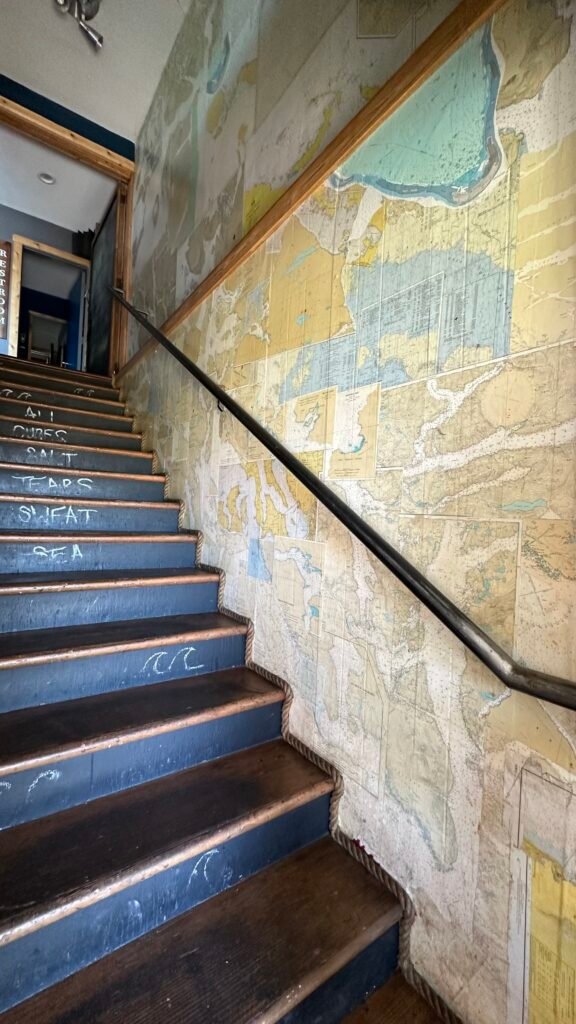
Darrell Fuhriman sent me these pics from the Salt Pub in Ilwaco, Washington.
“They decorated with old nautical charts, including a lamp shade and wallpaper on the stairs and entryway. “
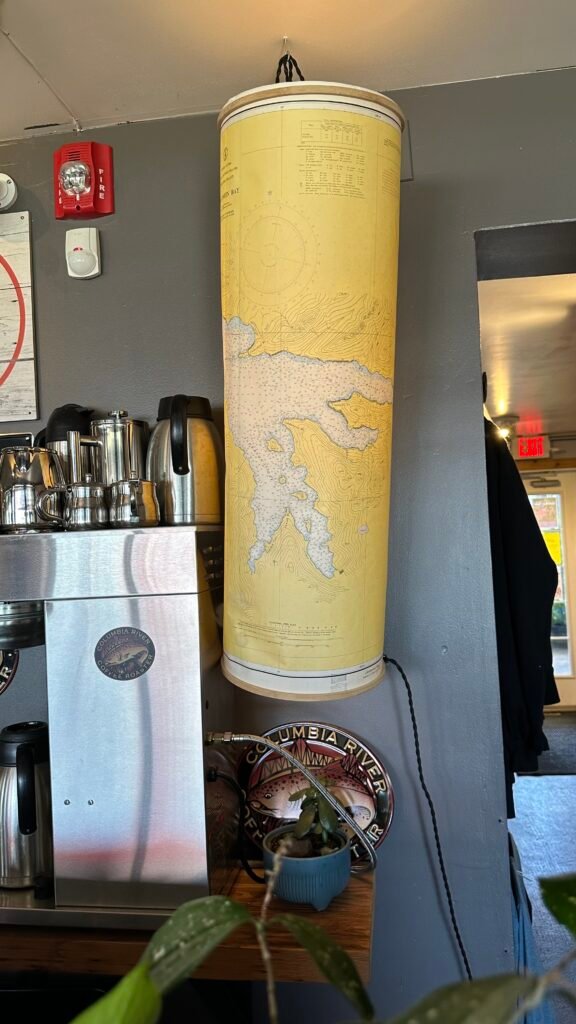
The stairs reference a quote by author Isak Dinesen. “The cure for anything is salt water — sweat, tears, or the sea.”
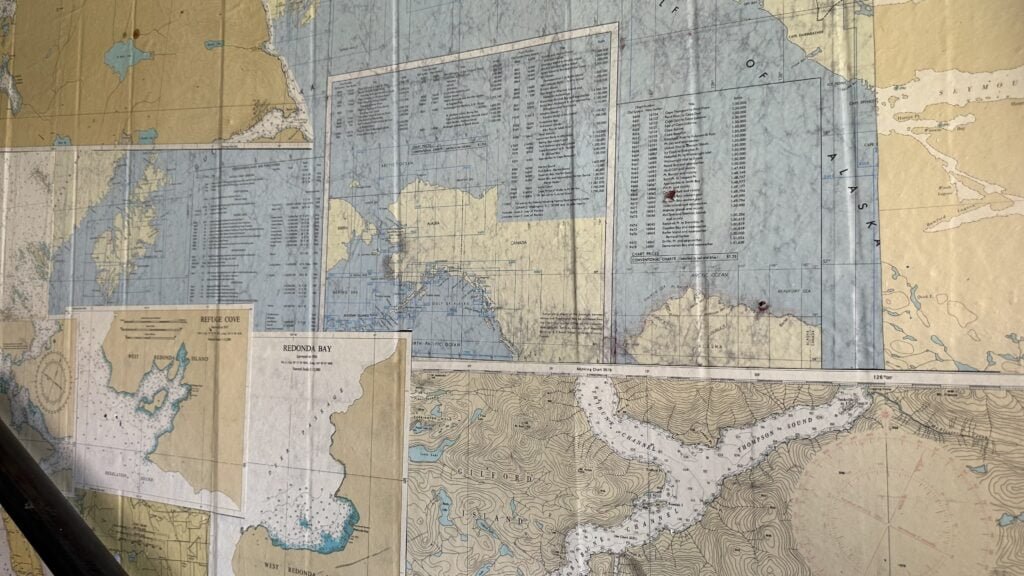
MapsintheWild The Cure for Anything is Salt Water
-
 16:34
16:34 GeoSolutions: FOSS4G North America: GeoSolutions Sponsoring FOSS4GNA – Workshops, and Presentations
sur Planet OSGeoYou must be logged into the site to view this content.
-
 13:00
13:00 Mappery: Origin of the Species
sur Planet OSGeo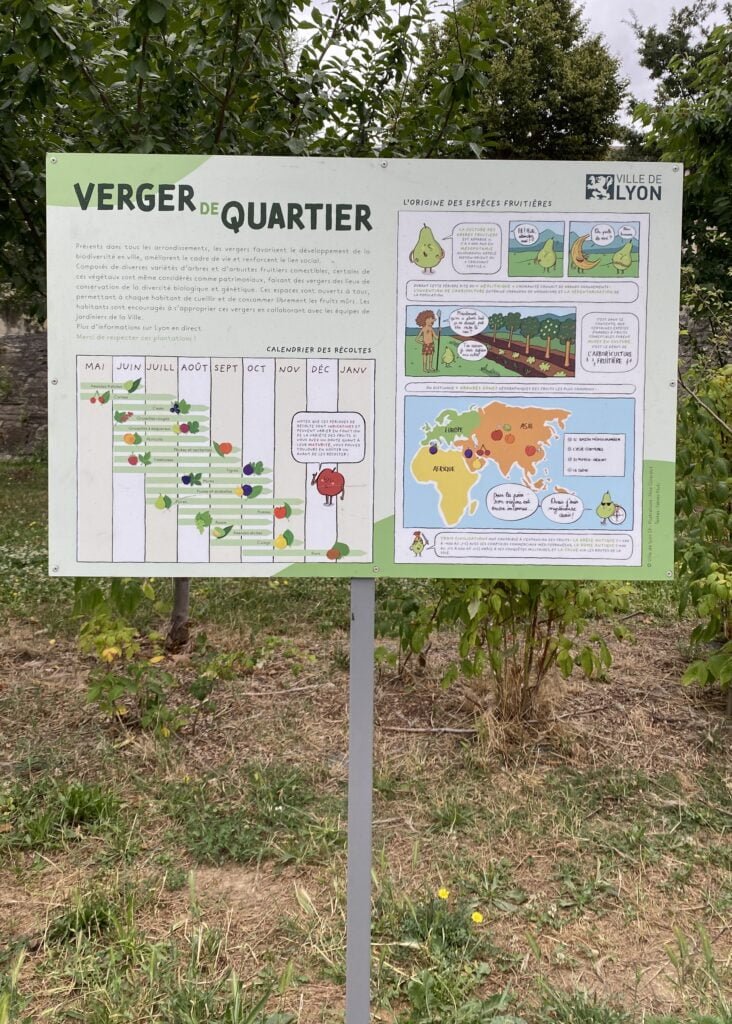
Reinder took this pic in a neighbourhood orchard “. along the river Saône in Lyon, named after a local heroine Mere Guy”
“In the 2nd arrondissement, the orchard created at Place Général Delfosse was named in honor of Mere Guy. A pioneer of the Meres de Lyon, she opened her restaurant in 1759 on the banks of the Rhône at Mulatière. She serves fish provided by her husband, a traditional fisherman, including her signature dish: eel matelote.” (Apologies for my translation)
[https:]The map shows the origins of the various species in the orchard
MapsintheWild Origin of the Species
-
 9:10
9:10 Adam Steer: Mapping a small farm part 2: microhydrology
sur Planet OSGeoThis is the first sequel to Mapping a small farm part 1. To summarise the first story, it walks through flight planning and practice, then data processing to get some first cut products, and a bit of mapping to show ideas about how accurate we think the product is. The products we’re interested in now… Read More »Mapping a small farm part 2: microhydrology
-
 9:04
9:04 TerriSTORY® – Une histoire de territoires OpenSource
sur OslandiaLorsque nous avons commencé à travailler sur Terristory en 2018, c’était alors un POC (Proof Of Concept) commandé par AURA-EE, Auvergne Rhône-Alpes Énergie Environnement. Le premier sprint devait convaincre de la faisabilité et projeter les ambitions de l’association. 6 ans plus tard, la plateforme devenue publique est un projet OpenSource maintenu de façon autonome directement par AURA-EE.
Le développement de la plateforme s’est déroulé sur plusieurs années. Au départ Oslandia était le prestataire chargé de réaliser et conseiller l’AURA-EE sur le projet, mais il était prévu aussi de former petit à petit les équipes côté association et de transmettre le savoir pour un jour permettre une totale autonomie. En parallèle, il y avait une volonté forte de la part d’Oslandia d’arriver à terme à une ouverture du code source de l’application, ce qui était également une volonté d’AURA-EE dès le départ.
Publier le code source d’une application (ici un site web) n’est pas forcément une tâche difficile en apparence. On pourrait penser qu’il s’agit juste de créer un répertoire gitlab et d’y déposer le code. Dans les faits, c’est ce qui se passe. Néanmoins, une bonne préparation en amont est nécessaire si on souhaite une ouverture de qualité.
De nombreuses questions se bousculent alorsQuand doit-on publier ? Est-ce que la documentation est prête ? Dois-je traduire en anglais ? A-t-on résolu tous les bugs critiques ? Comment va se passer la publicité ? Y-a-t il un formalisme à respecter ? Les aspects juridiques sont-ils couverts ? Est-on prêt à recevoir les retours de la communauté ?
Les étapesLa première chose à faire était de choisir la licence. Dans le cas de Terristory c’est la GNU Affero (ou AGPL) version 3 qui a été sélectionnée, après étude des tenants et des aboutissants. Ici il s’agit d’un outil serveur, sur lequel AURA-EE et les différents partenaires impliqués au sein d’un consortium national voulaient que les modifications faites par les utilisateurs soient reversées.
Un premier travail de documentation et de structuration du code a été entrepris par AURA-EE. Avoir une bonne documentation, des guidelines sont essentiels pour s’assurer que toute personne intéressée par la réutilisation ou par la contribution au code puisse aisément installer, tester et ajouter de nouvelles fonctionnalités.
Le code de Terristory a également connu de nombreuses phases de refactoring, c’est à dire de réécriture de certaines parties parce qu’obsolète, pas assez efficaces ou suite à des changements de librairies utilisées. Outre les évolutions fonctionnelle d’une telle application, le refactoring constitue une partie importante de la vie du logiciel. D’autant plus sur les applications Web où les avancées technologiques sont rapides. Il faut maintenir le code, et suivre l’évolution des librairies sous-jacentes si on veut pouvoir faire évoluer le site plus facilement et par un maximum de personnes. Côté Oslandia, nous anticipons au mieux ces phases de développement pour éviter le jour J de devoir faire une revue totale et potentiellement complexe du code juste avant la publication.
Oslandia a accompagné AURA-EE sur toutes ces années, et a réussi à lui transmettre la culture de l’OpenSource, aussi bien techniquement que dans les méthodes de travail. Ainsi, les collaborateurs d’AURA-EE sont vite devenus des utilisateurs experts de Gitlab, des utilisateurs experts de la solution, puis des développeurs de l’application, pour enfin procéder eux-même à la libération publique du code. En tant qu’ancien développeur principal de l’application pendant plusieurs années, je suis personnellement assez fier du travail accompli et de la manière dont les choses se sont déroulées.
[Témoignage]Pierrick Yalamas, Directeur intelligence territoriale et observatoires à Auvergne-Rhône-Alpes Énergie Environnement :
Notre vision
« Oslandia a su nous accompagner durant les premières années du projet TerriSTORY® : des premiers développements à l’appui juridique (choix de la licence) pour l’ouverture du code. L’équipe est maintenant complètement autonome. L’ouverture du code début 2023 a déjà donné lieu (mi-2024) à plusieurs réutilisations, qui permettent d’enrichir les fonctionnalités de TerriSTORY®. »Le projet TerriSTORY® et la manière dont il s’est déroulé correspond à la vision d’Oslandia de la relation client : notre objectif est de fournir les outils et les méthodes permettant aux organisations que nous accompagnons d’être le plus efficace et le plus autonome possible. Et ce, sur tous les aspects d’un projet logiciel : technique, mais aussi organisationnel, juridique, sur l’infrastructure de développement et les process mis en place. Voir des solutions que nous avons ébauchées prendre leur propre autonomie, dans le respect de l’esprit du logiciel libre est une satisfaction et une fierté pour toute l’équipe, et nous sommes reconnaissants à l’AURA-EE de nous avoir fait confiance pour cela.
-
 4:00
4:00 Ian Turton's Blog: Adding a spell check to QGIS
sur Planet OSGeoAdding a Spell Check to QGIS(Or what to do on a rainy bank holiday in Glasgow)
This Monday was a local bank holiday in Glasgow (or at least the university) as a remnant of when the whole town took a train to Blackpool in the same two weeks so that the ship builders and steel works could stop in a coordinated fashion. As is required in the UK the weather was awful so I stayed in and being bored looked at my long list of possible projects. I picked one that has been kicking around on the list for a while adding a spell checker for QGIS. As a dyslexic I have spell checking turned on in nearly every program I enter text into including
vim,InteliJand my browser. So I have always felt that what QGIS really needed was a way to spell check maps before I printed them at A3 and put them on the wall.Back in 2019 North Road wrote a iblog post about custom layout checks and ended it with a throw away comment “It’d even be possible to hook into one of the available Python spell checking libraries to write a spelling check!”. I came across this when I was trying to see if there was an easy way for my students (many of whom have English as a second language) to avoid handing in projects with glaring (i.e. I can see them) spelling errors in the title. So I stuck the link on my backlog, until the proverbial rainy day came along.
ImplementationObviously I’m the last person who should be allowed to write spell checking software, but the joy of open source is that for things like this someone else has almost certainly already done it. So a quick duck-duck-go found me installing
pyspellcheckwhich seemed like it would do what I want. It has a pretty easy interface in that once you’ve created a spell checker object, you can just pass in a list of words and it will return a list of (probably) misspelled words and a method to give the most likely correction and another method to give you list of other possibilities. Armed with this I could create a method to find and check all the text elements of a print layout.@check.register(type=QgsAbstractValidityCheck.TypeLayoutCheck) def layout_check_spelling(context, feedback): layout = context.layout results = [] checker = SpellChecker() for i in layout.items(): if isinstance(i, QgsLayoutItemLabel): text = i.currentText() tokens = [word.strip(string.punctuation) for word in text.split()] misspelled = checker.unknown(tokens) for word in misspelled: res = QgsValidityCheckResult() res.type = QgsValidityCheckResult.Warning res.title = 'Spelling Error?' template = f""" <strong>'{word}</strong>' may be misspelled, would '<strong>{checker.correction(word)}</strong>' be a better choice? """ possibles = checker.candidates(word) if len(possibles) > 1: template += """ Or one of:<br/> <ul> """ for t in possibles: template += f"<li>{t}</li>\n" template += '</ul>' res.detailedDescription = template results.append(res) return resultsAnd in theory, that was that! But I’m pretty sure that my students (and everyone else) probably didn’t want to cut and paste that into the console every time they wanted to spell check a map. So, I looked at how to package this up for QGIS. I built a plugin (using the plugin builder tool), but then things got a little tricky as I can’t see any way for a plugin to add itself to the print layout rather than the main QGIS window (please let me know if it is possible), and it seemed unintuitive to make people press a button in one window to effect another one, besides the whole point of being a
QgsAbstractValidityCheckwas that the method is automatically run on print. So I didn’t need most of the plugin code or did I? On further thought I did, there is a need for some GUI as the user can pick which language they want to use in the spell check.pyspellcheckcan spell check English, Spanish, French, Portuguese, German, Italian, Russian, Arabic, Basque, Latvian and Dutch (so if those are your language then please test this for me). I also thought that providing the option to supply a different to the default personal dictionary might be useful. So that made use of the dialog that pops up when you hit the plugin.But it turns out you can’t register a class method as as a
QgsAbstractValidityChecksince it gets confused when QGIS calls it later. So I had to move my checker method outside the plugin class. But then I couldn’t access the language and dictionary that was set in the GUI! Some more searching gave me the following code:_instance = plugins['qgis-spellcheck'] checker = _instance.checkerWhereby I can pull out the named plugin and grab it’s spell checker, which was created in the plugin’s
Future Work__init__method. I seem to have a small issue that the user’s profile is not set when that runs which messes up where the personal dictionary is put (again if you know how to fix this let me know).Ideally, I’d like the spell checker to scan and highlight the text in the boxes as I typed but I fear that is beyond my understanding of the QGIS/Qt interface. Next highest on my wish list is for the list of spelling issues to be non-modal so I can cut and paste fixes into the text box, rather than having to memorise the correct spelling, close the window and then type it in (again answers on a github issue).
I’m sure all sorts of things will come up once people start using it, so as usual issues and PRs are welcome at [https:]
-
 13:00
13:00 Mappery: Mitchell Library, Sydney
sur Planet OSGeo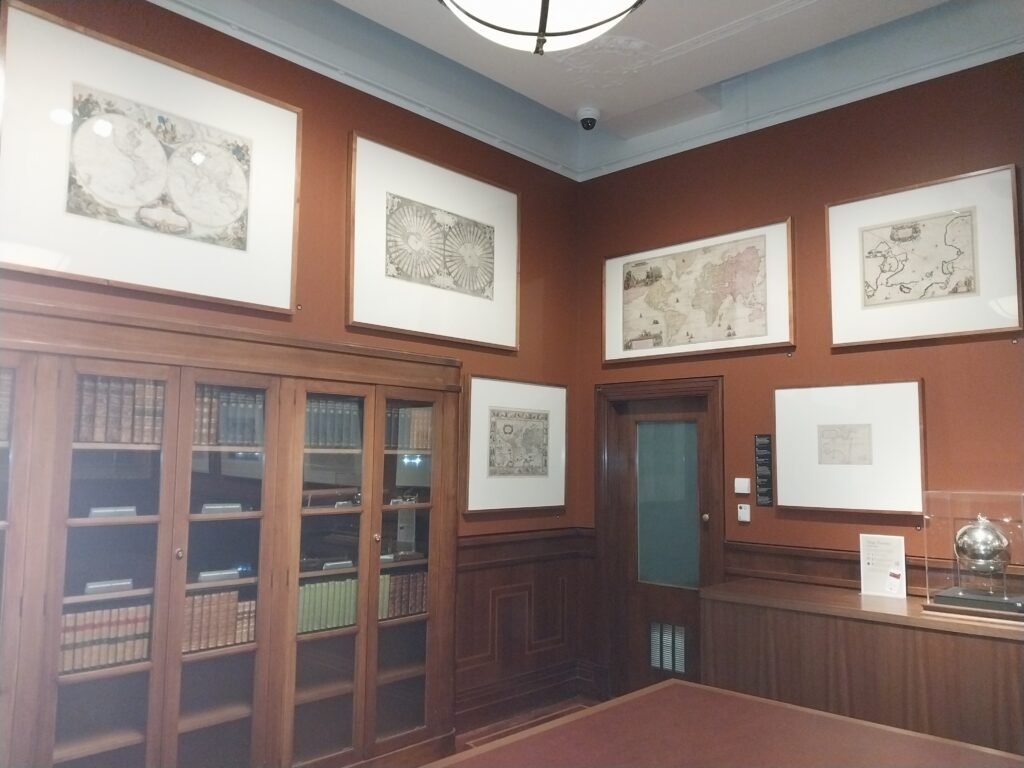
Another one from Anna Barca
“From the map room in First floor in the Mitchell Library building in the State Library of Sydney. I love looking at those historical art works and think about how maps were made in “the old days” and what was then the focus of the drawings.” (Me too!)
MapsintheWild Mitchell Library, Sydney
-
 22:46
22:46 QGIS Blog: Plugin Update – June, 2024
sur Planet OSGeoIn the month of June, 23 new plugins were published in the QGIS plugin repository.
Here follows the quick overview in reverse chronological order. If any of the names or short descriptions catches your attention, you can find the direct link to the plugin page in the table below:
Heritage Inventory Digitally register, manage, and visualise heritage resource data with this inventory worksheet plugin. Commuting Analysis This plugin analysis and visualises commuting data. Supervised Classifier A plugin to classify selected raster file with reference Field Stats This plugin calculates basic stats, graph histogram and boxplot Curvilinear Coordinator Plugin for river data conversion from Cartesian to curvilinear orthogonal system Konwerter PL-ETRF2000 PL-2000 Konwerter wspó?rz?dnych punktu uk?adu PL-ETRF2000 do uk?adu PL-2000 EIS QGIS Plugin Comprehensive mineral prospectivity mapping and analysis framework mgwr_plugin A QGIS plugin for Multiscale Geographically Weighted Regression (MGWR) D2S Browser This plugin allows you to browse your data on a D2S instance. WAsP scripting Scripts for fetching, creating and saving WAsP map files CSMap Plugin DEM?GeoTIFF???CS????????QGIS???????? Fast Line Density Analysis A fast line density visualization plugin for geospatial analytics Unsupervised Classifier Plugin for unsupervised classification of satellite images BathyFlowDEM Anisotropic interpolation for bathymetric data Hankaku Converter This plug-in converts string attribute values to full-width (Zenkaku) and half-width (Hankaku) characters to each other. Spot Height Extractor This plugin extracts spot heights from an elevation model. Power Clipboard Plugin to easy copy/zoom to XY/YX coords. Pan Europeo Ponders very large and distinct rasters with different utility functions trainminator2 Plugin de labellisation ?????(DigitalTwin) QGIS plugin for DigitalTwin Band Stacker A plugin to stack bands from selected raster layers Georeferencer Extension Extension to the Raster Georeferencer Plugin CartoGrapher This plugin provides commonly used methods to produce a generalized map. -
 13:00
13:00 Mappery: Explosion de la Liberté
sur Planet OSGeo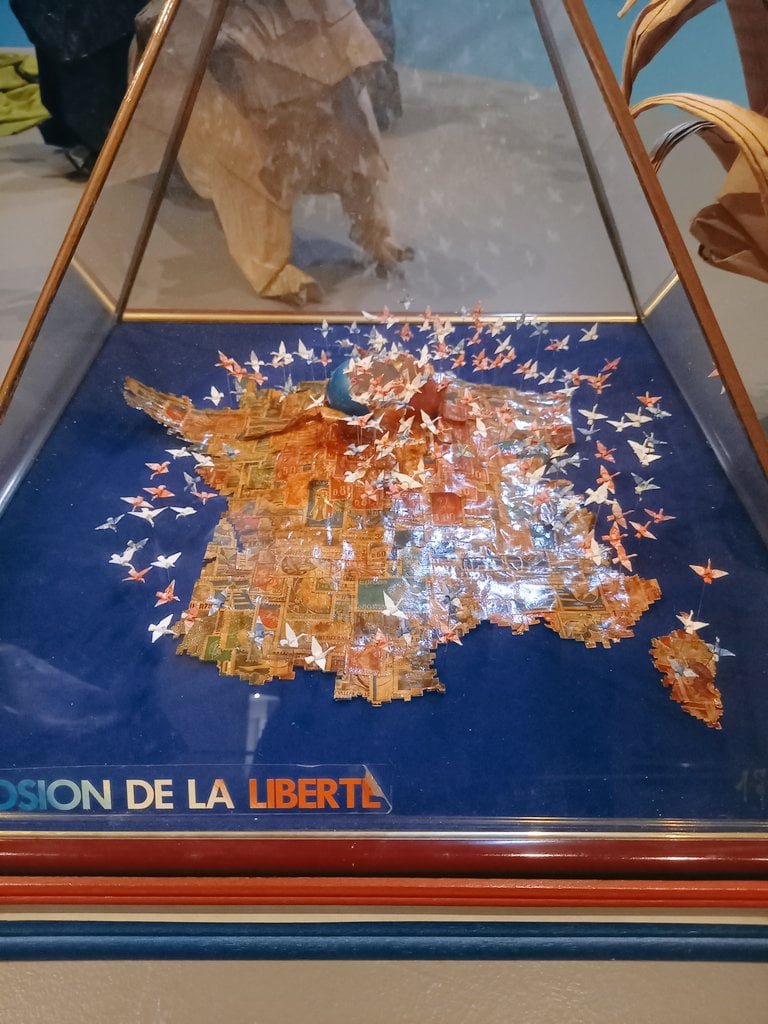
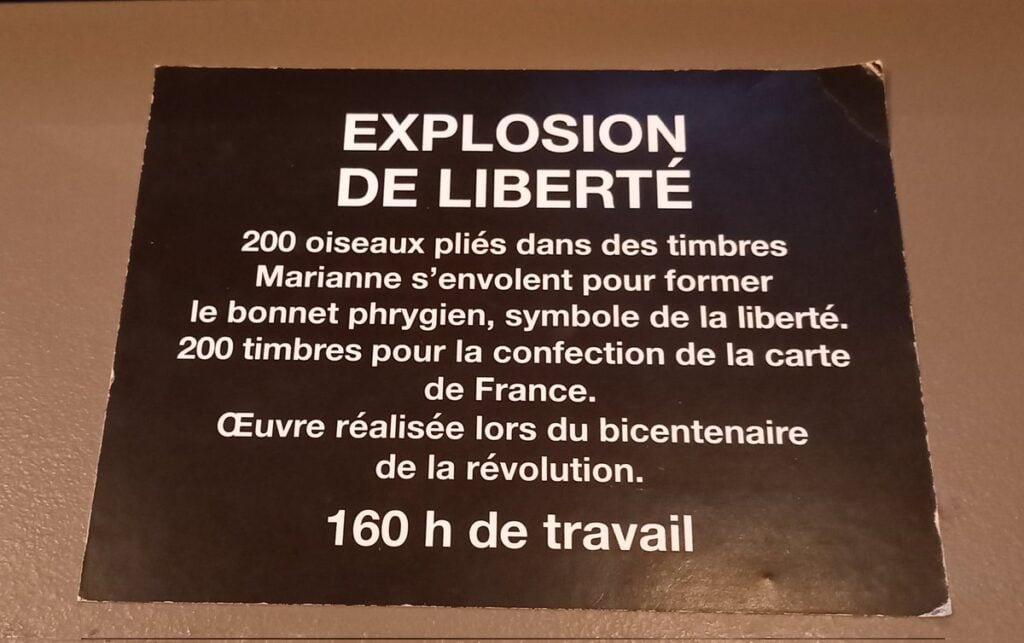
Anne L. shared these pictures last year. What could be better to celebrate Bastille Day this year? The Liberty Explosion is made with 200 stamps representing Marianne, the Symbol of the French Revolution for the Liberty, and the explosion takes the shape of the Phrygian cap.
Happy Bastille Day!
MapsintheWild Explosion de la Liberté
-
 13:00
13:00 Mappery: How goes the World?
sur Planet OSGeo
Reinder spotted this atlas in a bookshop in Lyon, “saw this Asia-Australia centered atlas cover in Librairie Passages, in Lyon, France.”
Centering the world map on Asia and Australia (which places the Americas to the east) reminds us thatthe adoption of the Prime Meridian through Greenwich was a choice by European cartographers not some inalienable geographic rule.
MapsintheWild How goes the World?
-
 21:35
21:35 KAN T&IT Blog: IOT Solution Congress en Brasil, nuestra experiencia
sur Planet OSGeoEl pasado mes de junio se llevó a cabo el IOT Solutions Congress en la ciudad de San Pablo, Brasil, donde más de 5.000 personas se reunieron para ver las soluciones más avanzadas en la industria del Internet de las Cosas (IOT).
El Internet de las Cosas es un concepto tecnológico que se resume como una red de dispositivos interconectados, ya sea a través de internet u otro tipo de redes, con el fin de enviar y recibir información en tiempo real y de forma automatizada.
Como muchas tecnologías innovadoras, el IOT tiene una amplia variedad de aplicaciones y usos, y esto se vió reflejado en la diversidad de las empresas que se acercaron al evento de San Pablo para conocer más sobre el tema. Se destacó la presencia de empresas de la industria petroquímica, minera, agrícola, de la construcción y organismos gubernamentales.
En esta ocasión KAN participó del evento con un stand y con un espacio en el Startup Stage, donde Ariel Anthieni (CEO) dió una charla sobre las aplicaciones y beneficios de los Gemelos Digitales (Digital Twins) con un enfoque particular en el monitoreo de tránsito de las ciudades.
Un Gemelo Digital es una réplica digital altamente precisa de objetos de todo tipo, desde vehículos y turbinas hasta ciudades enteras, cuyo fin es el de crear simulaciones que puedan optimizar el uso de dichos objetos. El mayor valor que otorga un Gemelo Digital es que utiliza datos reales para llevar a cabo estas simulaciones.
Primero se recolectan los datos utilizando dispositivos de telemetría IOT (sensores térmicos, caudalímetros, acelerómetros, etc.), luego se procesa esta información y finalmente se vuelca sobre el modelo virtual. Utilizando este modelo se pueden realizar diferentes tipos de simulaciones, analizar cada uno de los distintos escenarios y buscar mejoras para optimizar los recursos que se disponen.
Por ejemplo, utilizando sensores de vibración y un gemelo digital, se puede analizar el uso real de una bomba de agua, simular distintos escenarios y establecer cuándo debe hacerse el mantenimiento preventivo óptimo según los datos obtenidos.
Para el caso de las ciudades, Ariel explicó en su charla que los Gemelos Digitales permiten ayudar a los organismos gubernamentales a ver de forma anticipada el impacto que determinadas políticas públicas pueden tener en la organización de la ciudad.
Ariel lo explica en dos ejemplos sencillos: Conociendo el movimiento real de los colectivos en las ciudades, se puede simular el impacto que tendrán en sus recorridos si una avenida principal es clausurada completamente. Esto permite al gobierno buscar la reorganización óptima y desplegar eficazmente a los equipos de tránsito que llevarán a cabo la tarea.
Otro ejemplo se ve en la ciudad de Japón, donde el gobierno utiliza Gemelos Digitales para realizar simulaciones de terremotos y tsunamis para mejorar su capacidad de respuesta y recuperación ante los desastres naturales.
En conclusión, KAN cumplió con su cometido en el congreso de IOT logrando mostrar una solución vanguardista dentro de la industria IOT y dejando en claro que es una de las startups a seguir.
-
 21:23
21:23 Free and Open Source GIS Ramblings: Trajectools 2.2 released
sur Planet OSGeo
If you downloaded Trajectools 2.1 and ran into troubles due to the introduced scikit-mobility and gtfs_functions dependencies, please update to Trajectools 2.2.
This new version makes it easier to set up Trajectools since MovingPandas is pip-installable on most systems nowadays and scikit-mobility and gtfs_functions are now truly optional dependencies. If you don’t install them, you simply will not see the extra algorithms they add:

If you encounter any other issues with Trajectools or have questions regarding its usage, please let me know in the Trajectools Discussions on Github.
-
 15:47
15:47 WhereGroup: Volumendifferenzen, Zonenstatistik und mehr: wie Geoinformationssysteme (GIS) beim Wiederaufbau des Ahrtals helfen
sur Planet OSGeoGeoinformationssysteme unterstützen beim Wiederaufbau im Ahrtal nach der katastrophalen Flutkatastrophe 2021. Mit QGIS machen wir Daten sichtbar für diese Herkulesaufgabe, um Maßnahmen für den Wiederaufbau abzuleiten.





